FAQ - Advanced Bathroom Queries
What Countries Have the Best Toilets
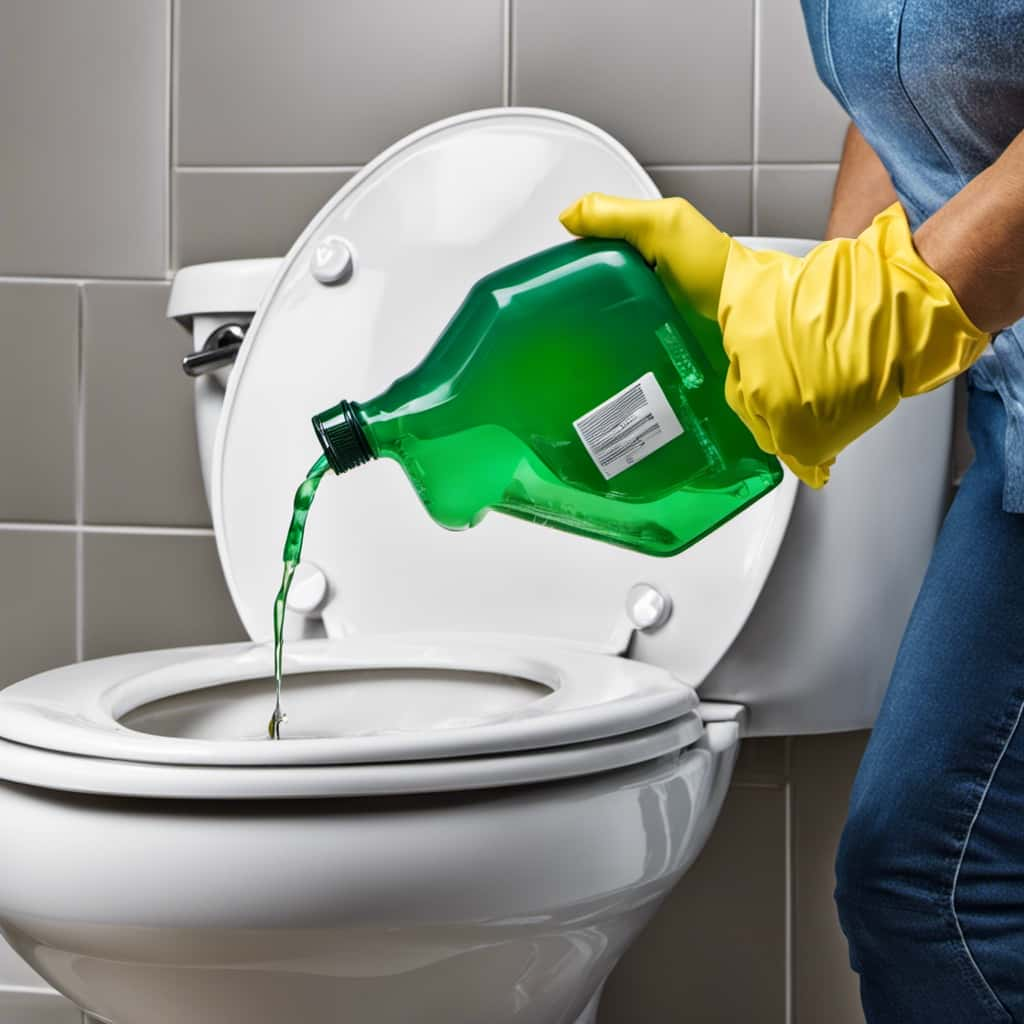
We’ve all experienced it – looking for a clean and functional bathroom while traveling in another country.
So, which countries have the best toilets? Japan, Singapore, and Switzerland are often hailed as leaders in this field.
These countries prioritize advanced toilet technology, cleanliness, and maintenance. With features like bidets, heated seats, and self-cleaning functions, their high-quality toilets are a cut above the rest.
Not to mention, they pay close attention to the cleanliness and accessibility of their public restrooms.
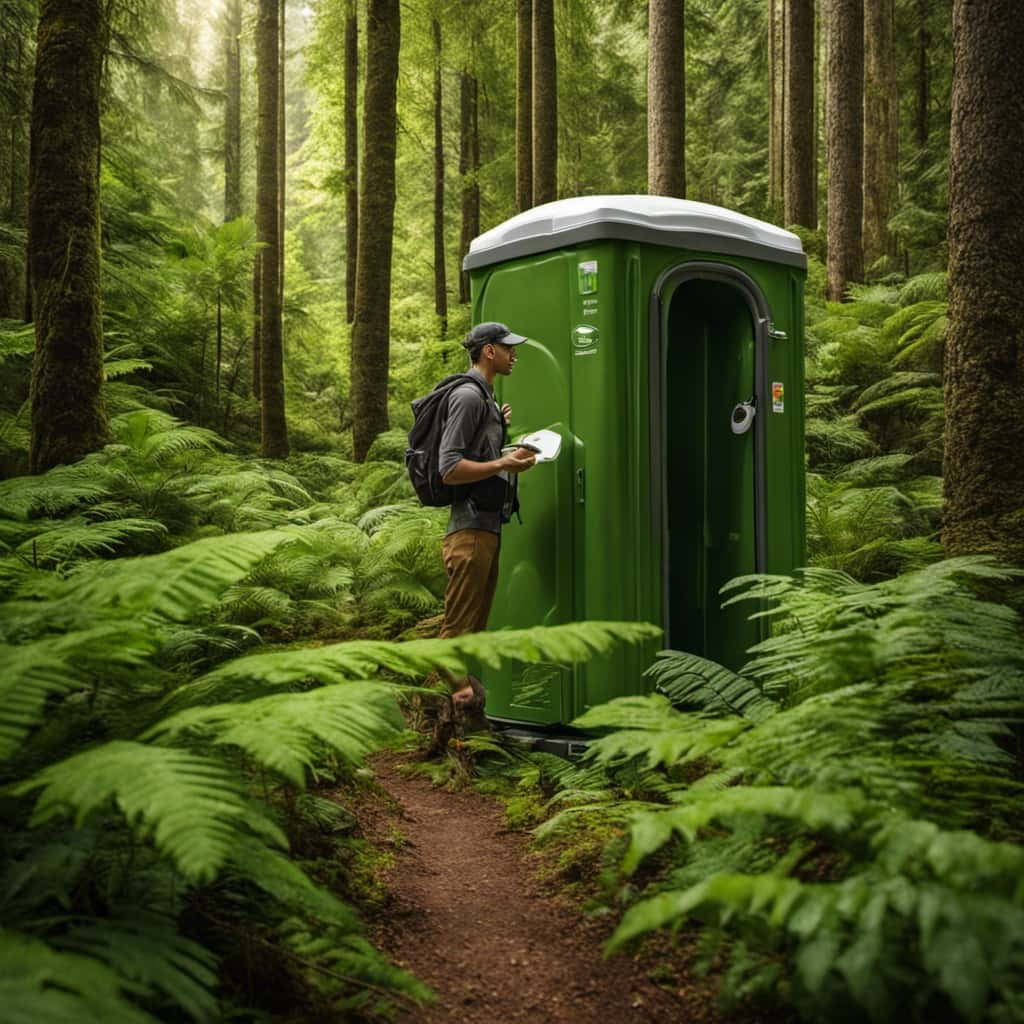
If you’re after a top-notch bathroom experience, these countries should be at the top of your list.
Key Takeaways
- Japan and Singapore have advanced toilet technology and cleanliness initiatives, with features such as bidets, self-cleaning functions, and strict regulations for restroom cleanliness.
- Singapore emphasizes efficient toilet infrastructure and advanced restroom technologies, including smart toilets with seat temperature control and touch-free faucets.
- Switzerland is known for its high-quality toilets and attention to detail in maintenance, reflecting Swiss precision and cleanliness.
- Canada, Australia, the UAE, and Finland prioritize cleanliness, comfort, and design in their restrooms, with features such as spaciousness, luxury, and Scandinavian design principles.
Japan: A Toilet Technology Powerhouse
We believe that Japan has established itself as a toilet technology powerhouse. Japanese toilet culture is known for its high tech restroom innovations and automated toilet functions. The country has made significant advancements in toilet technology, incorporating smart toilet features and introducing innovative restroom solutions.
Japanese toilets often include features such as bidets, heated seats, and self-cleaning functions. These toilets also boast high-tech elements like water jets, air dryers, and automatic lid opening and closing mechanisms. Some even have computerized voices, massage functions, and self-lowering seats.
Japan’s commitment to toilet technology has resulted in the creation of user-friendly toilets with adjustable rinsing and bidet water settings, seat temperature control, and even music options. The country’s dedication to innovation in this area has made it a global leader in the field of toilet technology.
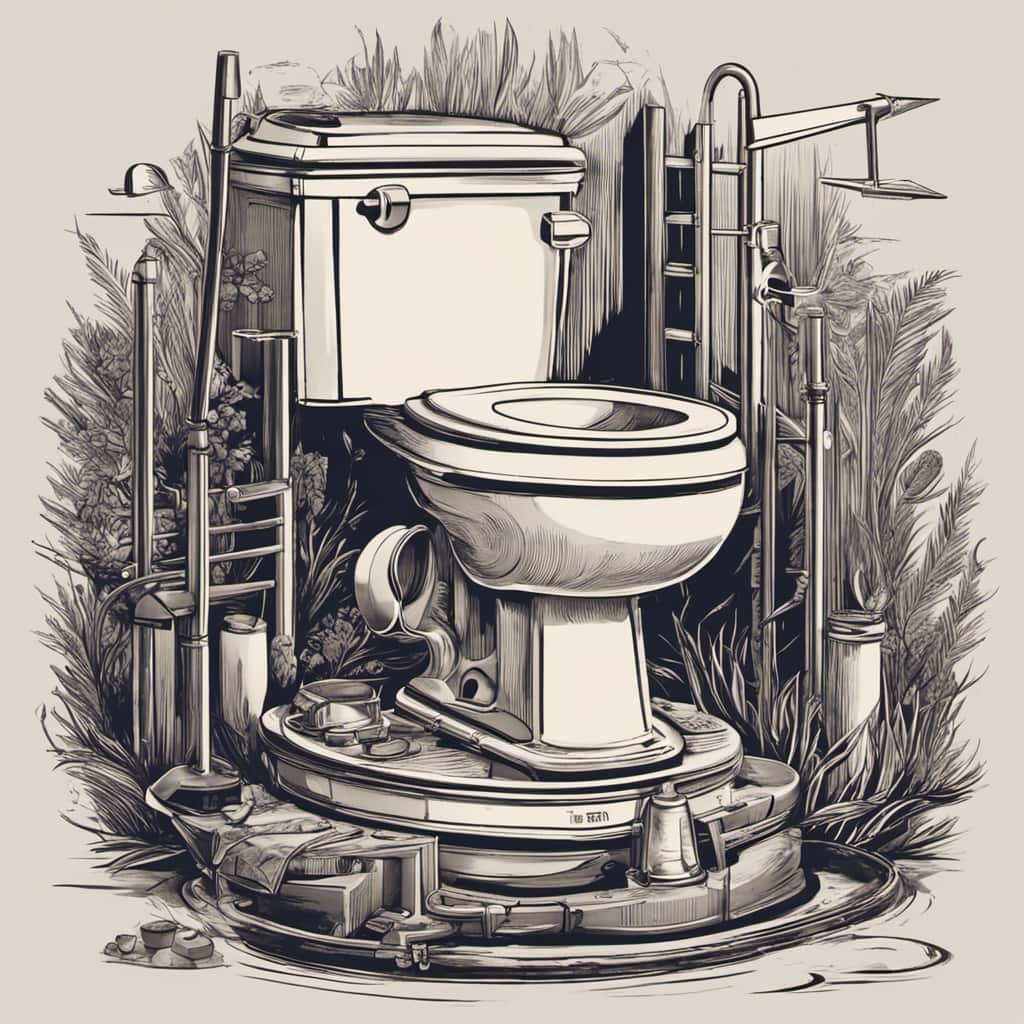
Singapore: Cleanliness and Efficiency in Restrooms
When it comes to restroom cleanliness initiatives, Singapore takes the lead with its strict regulations and high standards. The city-state has implemented various measures to ensure that public restrooms are kept clean and well-maintained, including regular inspections and the use of automated cleaning systems.
In addition, Singapore boasts an efficient toilet infrastructure, with easily accessible and well-equipped facilities throughout the city. These efforts, combined with the advanced restroom technologies available, contribute to Singapore’s reputation for cleanliness and efficiency in its restrooms.
Restroom Cleanliness Initiatives
One of the most effective restroom cleanliness initiatives can be found in Singapore, where a comprehensive system has been implemented to ensure the cleanliness and efficiency of public restrooms. This initiative has resulted in several notable benefits:
- Public Health Benefits: By maintaining clean restrooms, Singapore has successfully reduced the spread of diseases and improved public health.
- Mobile App Rewards: The government of Singapore encourages restroom cleanliness by offering cash rewards to users who report clean or dirty restrooms through a mobile app. This incentivizes individuals to actively participate in maintaining cleanliness.
- Automated Cleaning Systems: Singapore has introduced automated self-cleaning systems in public restrooms, ensuring a high level of cleanliness without relying solely on human effort.
- Restroom Etiquette Education and High-Quality Products: Measures have been taken to educate the public about proper restroom etiquette and cleanliness. Additionally, Singapore uses high-quality products to maintain cleanliness and hygiene in public restrooms.
These initiatives have been successful in providing clean and hygienic facilities for residents and visitors, promoting public health and well-being. With such effective restroom cleanliness initiatives in place, it’s important to consider the efficient toilet infrastructure that supports these efforts.
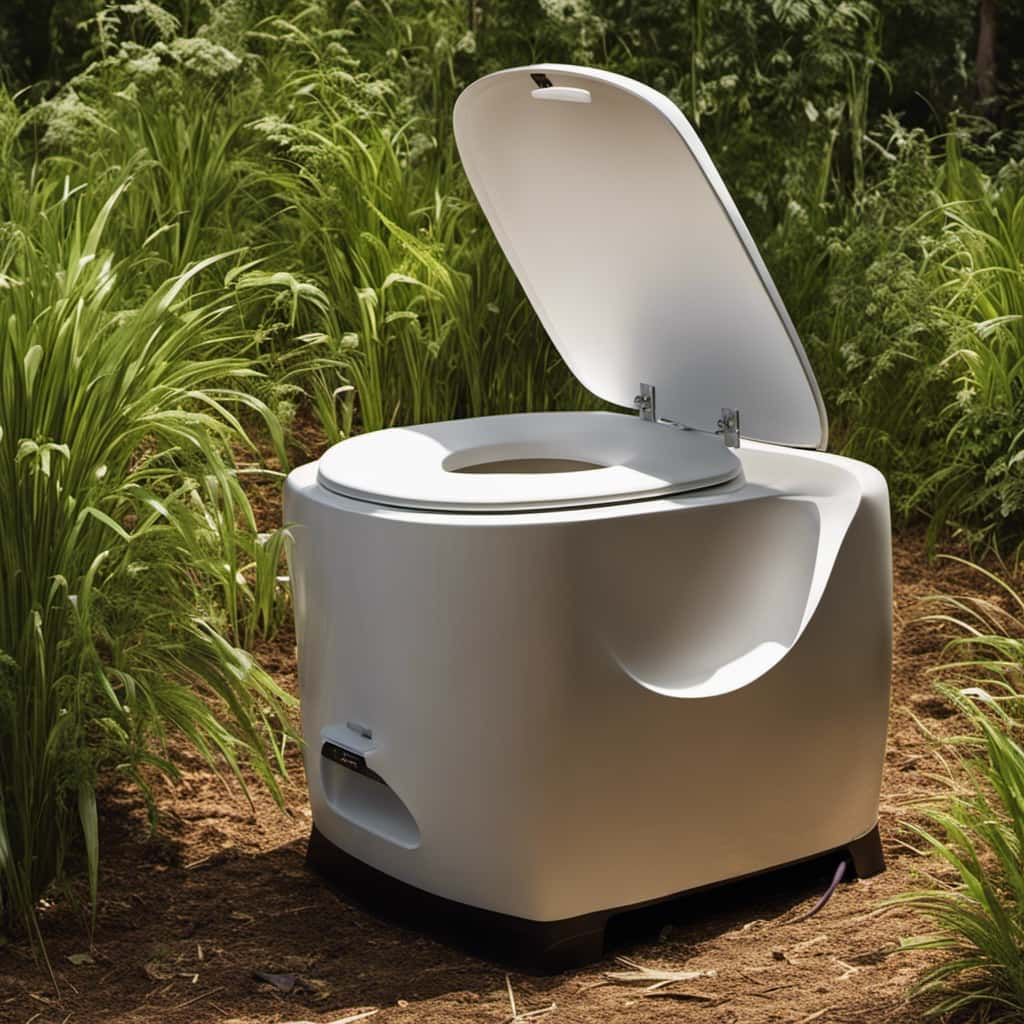
Efficient Toilet Infrastructure
Continuing from the previous subtopic, let’s delve into the efficient toilet infrastructure in Singapore, specifically focusing on the cleanliness and efficiency of restrooms.
Singapore is renowned for its emphasis on restroom cleanliness and efficiency, which is reflected in its well-maintained and easily accessible public toilets. The city-state has implemented various toilet accessibility initiatives to ensure that restrooms are available to all individuals, including those with disabilities. This commitment to accessibility not only promotes inclusivity but also has a positive impact on public health.
Well-maintained restrooms reduce the risk of disease transmission and contribute to a healthier population. Moreover, Singapore’s efficient toilet infrastructure brings economic benefits. Clean and well-maintained restrooms enhance the tourism experience, attracting visitors and boosting the economy. Innovations in toilet design, such as touchless fixtures and self-cleaning functions, further improve hygiene standards.
Additionally, Singapore prioritizes sustainable practices in toilet infrastructure, including water-efficient fixtures and waste management systems. Overall, Singapore’s commitment to cleanliness, efficiency, and sustainability in its restrooms sets a high standard for efficient toilet infrastructure worldwide.

Advanced Restroom Technologies
Let’s delve into the advanced restroom technologies that contribute to the cleanliness and efficiency of restrooms in Singapore. Here are four key aspects of these technologies:
- Smart toilets: The future of restroom technology. Singapore’s restrooms feature smart toilets equipped with advanced features such as seat temperature control, adjustable rinsing and bidet water settings, and self-lowering seats. These toilets enhance user comfort and hygiene.
- Hygienic restroom solutions: Innovations in cleanliness. Singapore prioritizes cleanliness by incorporating touch-free faucets, automated toilet seat covers, and self-cleaning functions in its restrooms. These innovations reduce the spread of diseases and ensure a high level of hygiene.
- Sustainable toilet systems: Eco-friendly approaches to restroom design. Singapore embraces sustainable toilet systems, such as water-saving fixtures and waste management technologies. These systems reduce water consumption and promote environmental sustainability.
- Accessibility in public restrooms: Ensuring inclusivity for all. Singapore’s restrooms are designed to be accessible to people with disabilities, featuring amenities like grab bars, wider stalls, and wheelchair-friendly layouts. These measures ensure that everyone can use restrooms comfortably and safely.
Switzerland: High-Quality Toilets and Maintenance
When it comes to Swiss toilets, quality and maintenance are top priorities. Switzerland is renowned for its advanced toilet technology and cleanliness, ensuring that public restrooms are kept in excellent condition.
With a focus on hygiene and cleanliness, Switzerland consistently ranks among the countries with the best public toilet infrastructure.
Swiss Toilet Technology
Our first-hand experience with Swiss toilet technology has shown us the exceptional quality and maintenance of their toilets. Here are four key aspects of Swiss toilet technology that make them stand out:
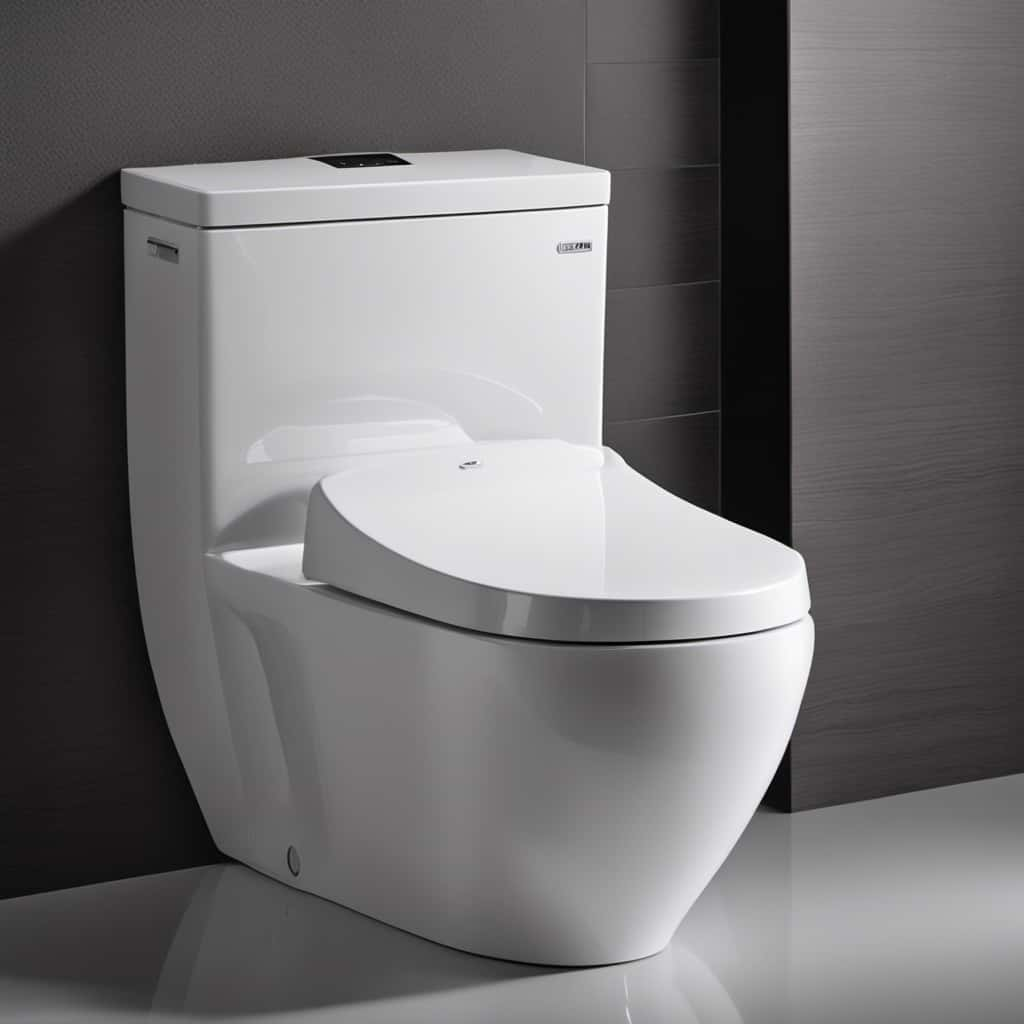
- Sustainability and Efficiency: Swiss toilets are designed to be environmentally friendly, with water-saving features that minimize water consumption and reduce the strain on natural resources.
- Smart Toilet Features: Swiss toilets often come equipped with advanced features like seat temperature control, adjustable rinsing and bidet water settings, and even automated lid opening and closing functions.
- Toilet Hygiene Practices: Swiss toilets prioritize hygiene with features such as automatic flushing, touchless controls, and self-cleaning functions. These features help prevent the spread of germs and ensure a clean and sanitary restroom experience.
- Public Restroom Accessibility: Switzerland places great importance on providing accessible public restrooms for everyone. They’ve implemented measures to ensure that restrooms are available in public spaces, including those for people with disabilities.
Swiss toilet technology not only focuses on providing a comfortable and convenient experience but also prioritizes sustainability, hygiene, and accessibility. This commitment to excellence extends to the maintenance of their toilets, ensuring that they’re always in top condition.
Transitioning into the next section, let’s delve into the topic of cleanliness and maintenance.
Cleanliness and Maintenance
To ensure high-quality toilets and maintenance, Switzerland prioritizes cleanliness and adheres to rigorous standards. The importance of toilet hygiene is recognized in Swiss culture, as clean restrooms have a significant impact on public health. By maintaining clean toilets, Switzerland reduces the spread of diseases and promotes good hygiene practices.
Strategies for maintaining cleanliness include regular cleaning schedules, well-stocked supplies, and thorough inspections. This commitment to cleanliness extends beyond public toilets, as many private establishments also uphold high standards. In addition to improving public health, clean and well-maintained toilets also have economic benefits. They enhance the tourism experience for visitors and contribute to a positive image of the country.
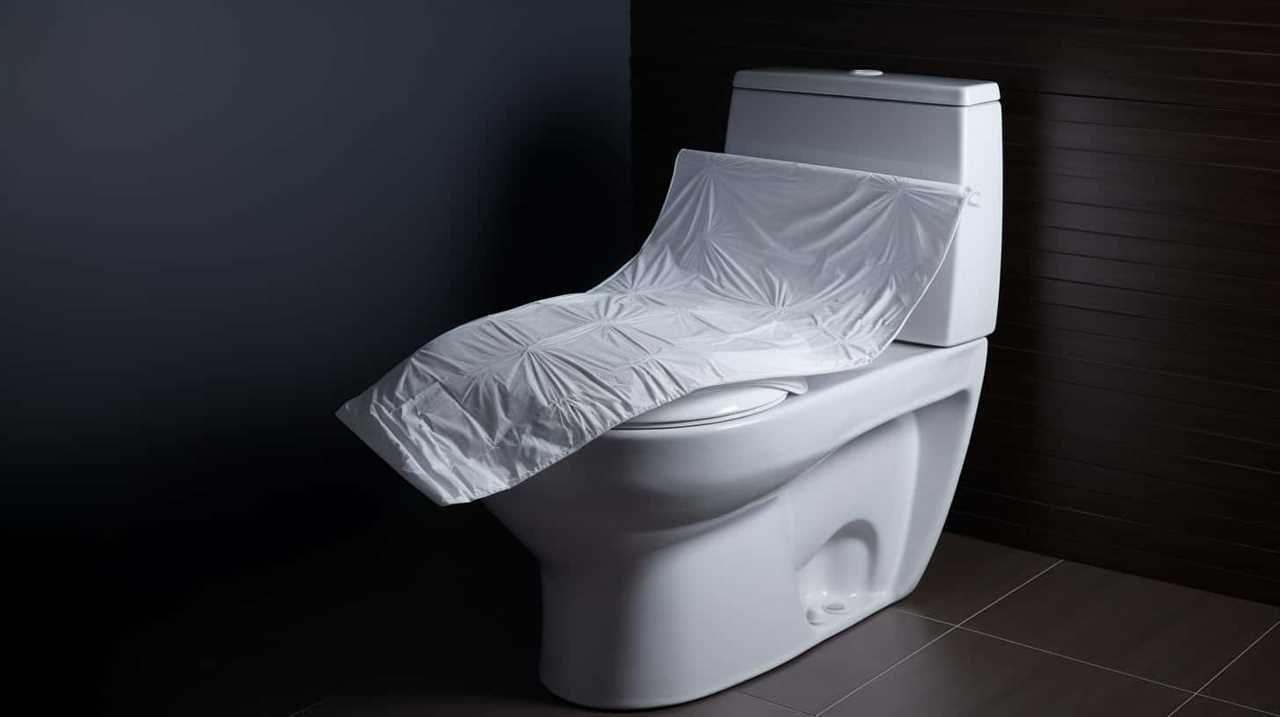
Cultural differences in toilet cleanliness standards may exist, but Switzerland sets a high benchmark for cleanliness and maintenance. Transitioning to the next section, South Korea also excels in toilet hygiene with its innovative toilet design and hygiene practices.
South Korea: Innovative Toilet Design and Hygiene
One of the countries renowned for its innovative toilet design and hygiene practices is South Korea. Here are four reasons why South Korea stands out in this field:
- South Korean toilet innovations: South Korea is known for its cutting-edge toilet technology, which includes features like heated seats, bidet functions, and even music or sound effects to mask embarrassing noises.
- Hygiene practices in South Korean restrooms: South Korea prioritizes cleanliness and hygiene in public restrooms. Automatic cleaning systems and hand sanitizers are available to ensure a clean and sanitary experience for users.
- Advantages of South Korean toilet design: The advanced features in South Korean toilets provide comfort and convenience, making the restroom experience more enjoyable for users.
- South Korean toilet technology advancements: South Korea continues to push the boundaries of toilet design, constantly introducing new technologies and improvements to enhance the user experience.
South Korea’s commitment to cleanliness standards in public restrooms, along with its innovative toilet design and technology advancements, make it a leader in the field of toilet innovation and hygiene.
Netherlands: Eco-Friendly and Sustainable Toilets
While discussing eco-friendly and sustainable toilets, it is important to highlight the efforts made by the Netherlands in promoting environmentally conscious toilet facilities. The Netherlands has invested in infrastructure development to enhance toilet facilities and contribute to public health and environmental sustainability. They have implemented water-saving technology and advanced flushing systems to reduce water consumption. Additionally, the Netherlands focuses on recycling and treating wastewater from toilets for agricultural purposes. This innovative approach not only helps in conserving water but also ensures efficient waste management. The Netherlands is committed to improving toilet infrastructure to better accommodate residents and visitors. It is evident that their dedication to eco-friendly and sustainable toilets is contributing to a healthier environment and promoting sustainable practices.
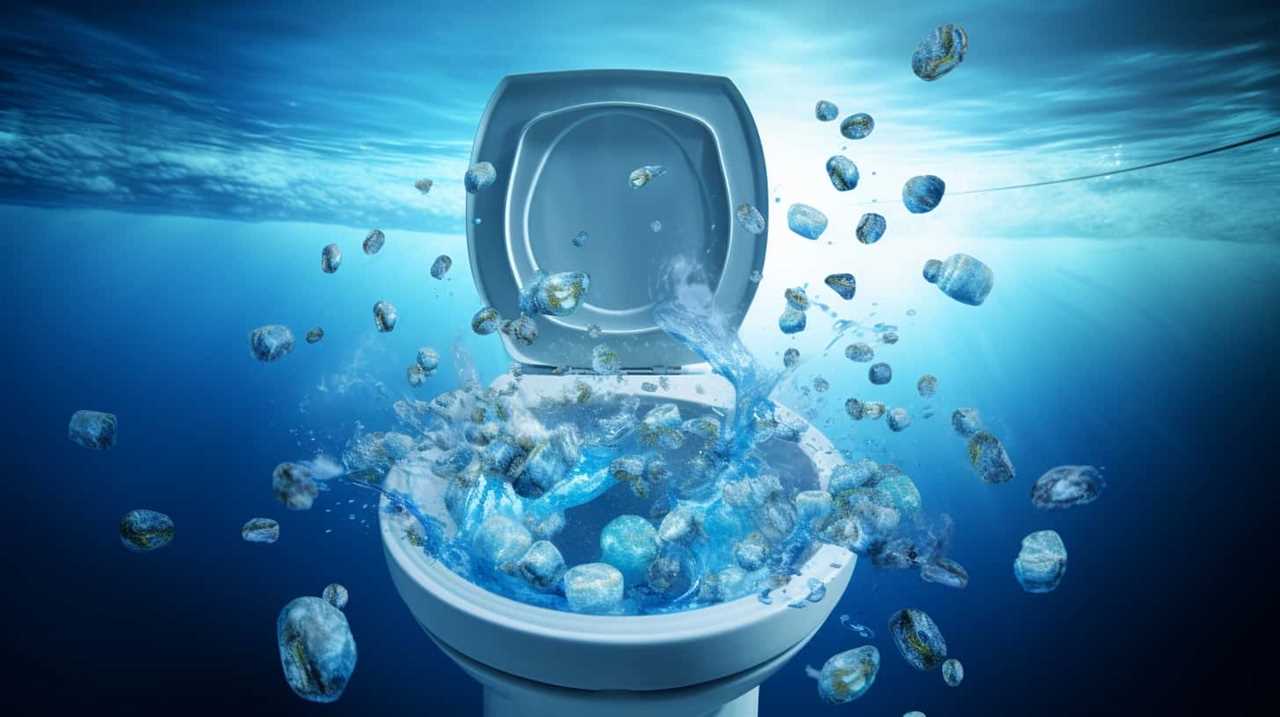
| Key Efforts by the Netherlands | |
|---|---|
| Water-saving Technology | Efficient flushing systems to reduce water consumption. |
| Wastewater Treatment | Recycling and treating wastewater from toilets for agricultural purposes. |
| Toilet Infrastructure Improvement | Investing in infrastructure development to enhance toilet facilities. |
| Public Health and Environmental Sustainability | Promoting eco-friendly and sustainable practices in toilet facilities. |
Germany: Focus on Cleanliness and Accessibility
We have found that German toilets are known for their cleanliness and accessibility. When it comes to accessible restroom design, Germany is at the forefront, ensuring that individuals with disabilities have equal access to public facilities. German toilet culture places a strong emphasis on hygiene, resulting in well-maintained and spotless restrooms. The country’s investment in infrastructure development for toilet facilities not only improves the overall quality of life but also has significant public health benefits.
With features like automatic flushing, touch-free faucets, and self-cleaning mechanisms, German toilets prioritize cleanliness and hygiene. The commitment to providing clean and accessible restrooms for residents and visitors contributes to the livability of German cities.
Transitioning into the subsequent section about Canada, we’ll now explore the country’s spacious and well-maintained restrooms.
Canada: Spacious and Well-Maintained Restrooms
When it comes to spacious and well-maintained restrooms, Canada stands out among other countries. With a commitment to public restroom accessibility and a strong hygiene awareness, Canada ensures that its restroom facilities are clean, comfortable, and up to high standards. The country invests in infrastructure development to enhance toilet facilities, improving the overall tourism experience. Canadians take pride in providing comfortable and hygienic restroom facilities, which contributes to the country’s livability and tourism experience. To ensure cleanliness, Canada has implemented restroom cleanliness campaigns and restroom maintenance strategies. Additionally, the country embraces restroom design innovation to create functional and user-friendly facilities. Overall, Canada’s dedication to maintaining high standards for restroom facilities sets it apart and makes it a favorable destination for those seeking clean and spacious restrooms.
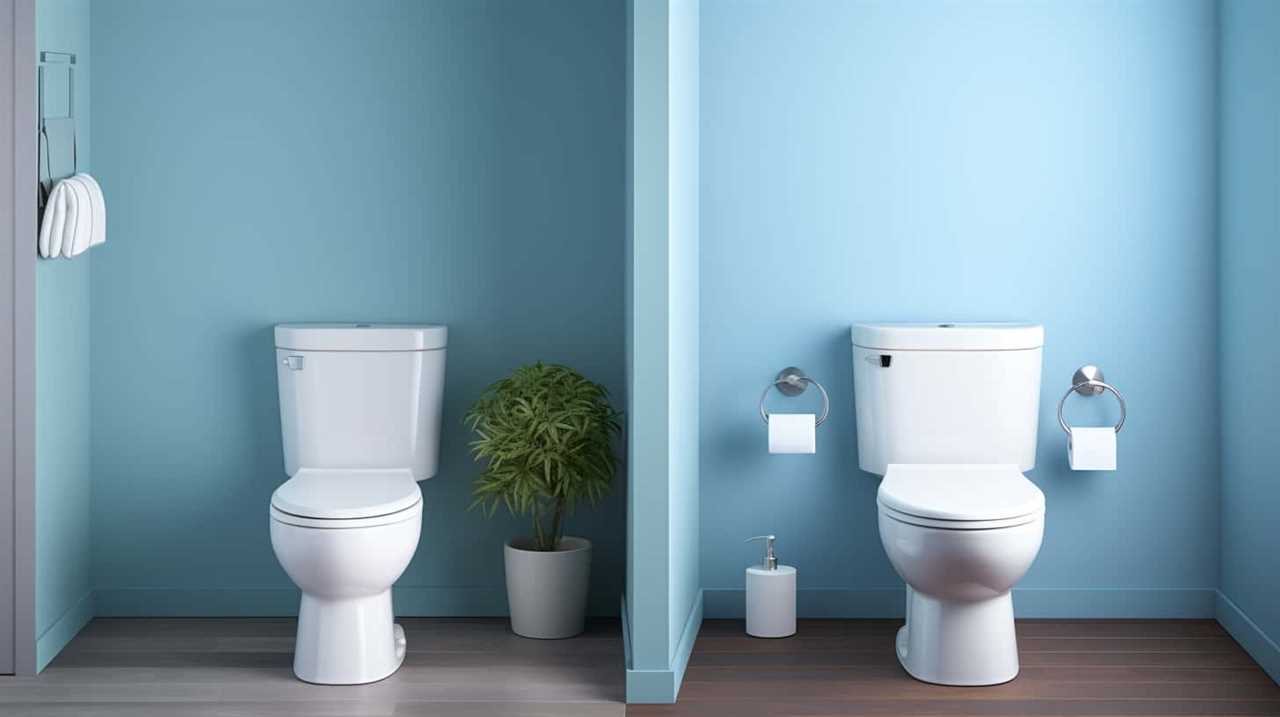
| Public Restroom Accessibility | Hygiene Awareness | Restroom Cleanliness Campaigns | Restroom Maintenance Strategies |
|---|---|---|---|
| High | Strong | Implemented | Embraced |
| Restroom Design Innovation | |||
| —————————– | ——————- | ——————————- | ——————————- |
| Functional and User-friendly |
Australia: Modern Amenities and Clean Facilities
Continuing the discussion from the previous subtopic, let’s delve into Australia’s modern amenities and clean facilities. Here are four reasons why Australia is known for having some of the best toilets:
- Public Health Benefits:
Well-maintained toilets in Australia contribute to public health by preventing the spread of diseases. Clean facilities help minimize the risk of infections and promote good hygiene practices. - Pollution Reduction:
Access to clean toilets in Australia plays a crucial role in reducing pollution. Proper sanitation facilities ensure that waste is managed effectively, preventing contamination of water sources and the environment. - User Comfort:
Australian restrooms prioritize user comfort by providing modern facilities. From spacious stalls to well-designed layouts, these toilets aim to enhance the overall experience for visitors. - Hygiene Standards:
Australia upholds high cleanliness and hygiene standards in its public restrooms. Regular maintenance and cleaning routines ensure that facilities are sanitary and pleasant for users.
Australia’s commitment to modern amenities and clean facilities not only improves public health but also enhances user comfort while reducing pollution. With their focus on hygiene standards and modern facilities, Australian toilets set a benchmark for restrooms worldwide.
United Arab Emirates: Luxurious and High-Tech Toilets
In our exploration of the topic ‘What Countries Have the Best Toilets’, let’s now delve into the subtopic of the United Arab Emirates and its offering of luxurious and high-tech toilets.
The United Arab Emirates (UAE) is renowned for its commitment to providing luxurious toilet facilities equipped with advanced technology. These toilets offer a unique and indulgent restroom experience for residents and visitors alike.
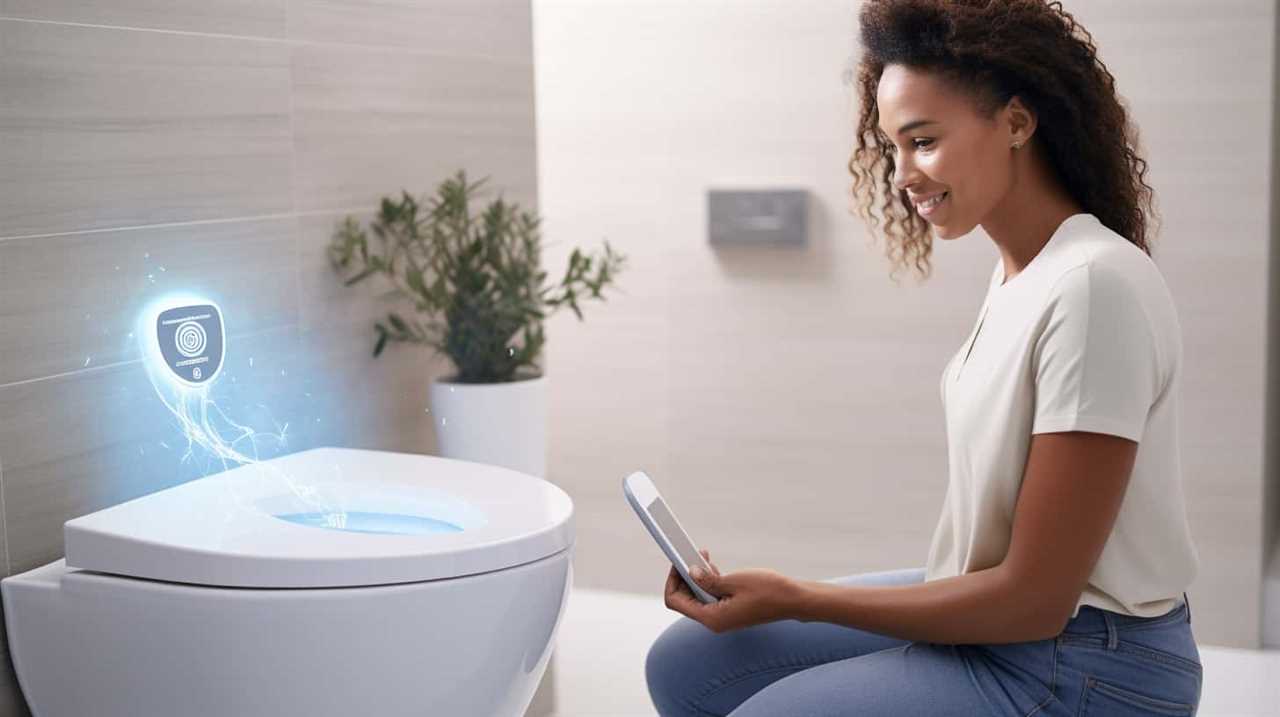
The UAE’s toilets boast features such as seat temperature control, adjustable rinsing and bidet water settings, computerized voices, and even massage functions. This investment in advanced toilet technology not only enhances the comfort and convenience of users but also has a positive impact on public health and contributes to a memorable tourism experience.
Particularly in Dubai, upscale hotels and shopping malls showcase luxurious and high-tech toilets, complete with heated seats, bidet functions, and automatic sensors. The UAE’s focus on providing top-notch restroom facilities ensures a pleasant and sophisticated restroom experience for all.
Finland: Public Toilets With Scandinavian Design
Let’s now explore Finland, where public toilets are designed with a Scandinavian aesthetic that combines functionality and aesthetic appeal. Here are some key points about Finnish public toilets:
- Scandinavian Design Influence: Finnish public toilets are heavily influenced by Scandinavian design principles, which prioritize simplicity, minimalism, and functionality. This design approach ensures that the toilets are visually pleasing while also serving their intended purpose effectively.
- Benefits of Well-Maintained Toilets: Finnish public toilets are well-maintained and clean, promoting public health and hygiene. Regular cleaning and maintenance ensure that the toilets are in excellent condition, providing a comfortable and pleasant experience for users.
- User Comfort in Finnish Toilets: The emphasis on aesthetics in Finnish restroom design extends to user comfort. These toilets often feature high-quality materials, such as stainless steel and natural wood, creating a sleek and modern look. The design also takes into account factors like seating comfort and accessibility.
- Impact of Advanced Features on Restroom Experience: Finnish public toilets are equipped with advanced features like sensor-operated faucets, touchless flushing systems, and automatic hand dryers. These features enhance the restroom experience by providing convenience and efficiency.
Frequently Asked Questions
Which Country Has the Best Toilets?
When considering the best toilets globally, it’s important to consider factors such as toilet innovations, sanitation standards, cultural differences in toilet design, public vs. private restroom facilities, and the impact of technology on toilet experiences.
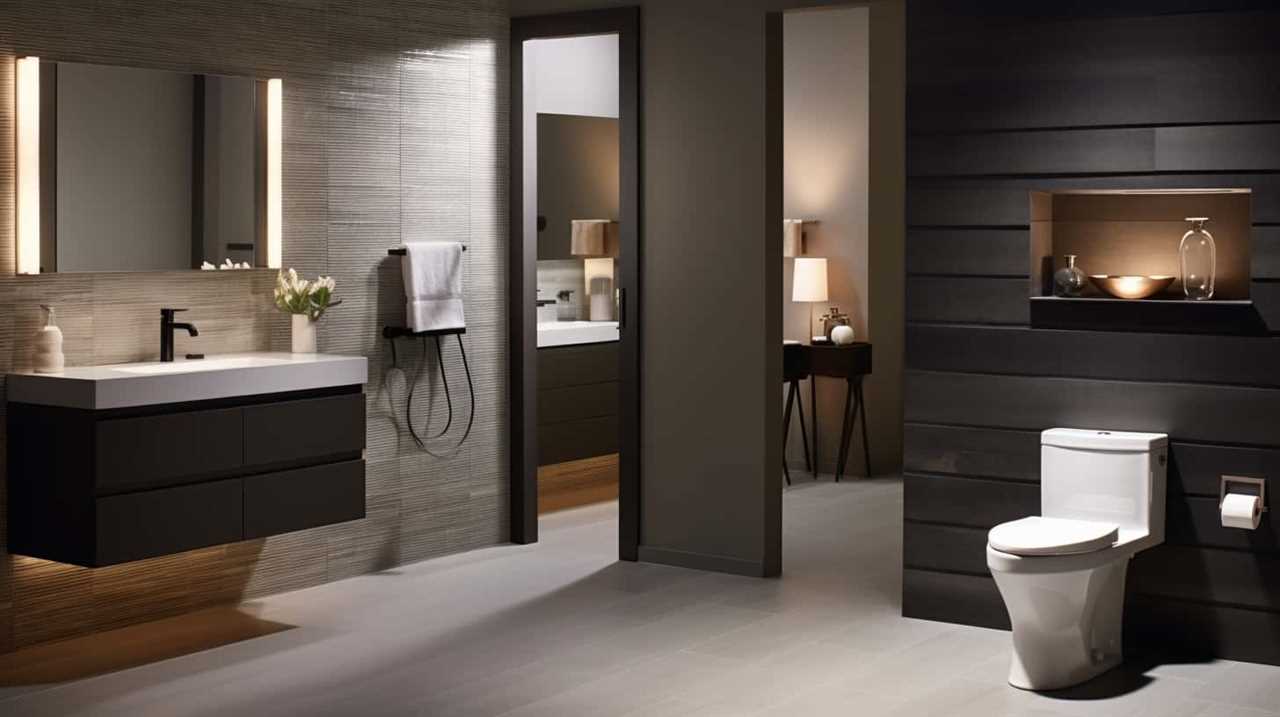
These factors greatly influence the quality of toilets in different countries. By analyzing these aspects, we can gain a comprehensive understanding of which countries excel in providing top-notch toilet facilities.
Where Is the Cleanest Toilet in the World?
When it comes to the cleanest toilet in the world, sanitation standards and public health play a crucial role. Maintaining proper toilet hygiene practices is essential for a clean and healthy environment.
From innovative toilet designs to efficient maintenance, the cleanest toilets prioritize cleanliness and user comfort. These toilets often incorporate advanced features such as self-cleaning functions and bidets, ensuring a hygienic experience for all users.
What Is the Best Restrooms in the World?
Innovative designs, hygiene standards, technology advancements, accessibility features, and environmental sustainability are key factors in determining the best restrooms in the world.
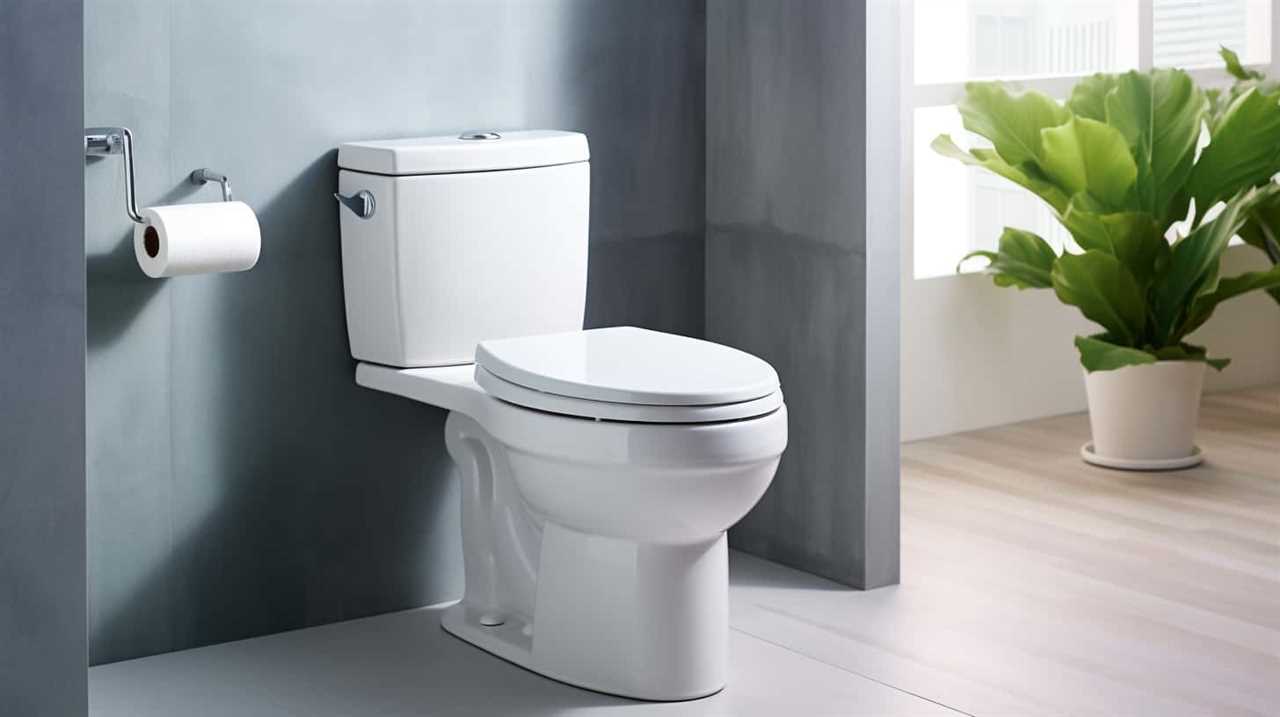
These restrooms prioritize cleanliness, often incorporating advanced features such as bidets, heated seats, and self-cleaning functions.
Additionally, they prioritize accessibility for all individuals, ensuring that restrooms are easily accessible for people with disabilities.
Furthermore, these restrooms focus on environmental sustainability by implementing water-saving technologies and eco-friendly materials.
Why Does Japan Have the Best Toilets?
Japan has the best toilets due to its advanced toilet technology, cultural importance of cleanliness, and environmental benefits.

Japanese toilets are equipped with features like bidets, heated seats, and self-cleaning functions. This advanced technology enhances the user experience and promotes hygiene.
Japan’s focus on cleanliness extends to public restrooms, which are well-maintained and equipped with amenities. The high standard of Japanese toilets has a positive impact on tourism and public perception.
Conclusion
In conclusion, after analyzing the data and considering factors such as infrastructure, cleanliness, and technology, it’s clear that Japan, Singapore, and Switzerland stand out as countries with the best toilets.
However, there are other countries such as South Korea, the Netherlands, Canada, Australia, the United Arab Emirates, and Finland that also offer impressive restroom facilities.

The advancements in toilet technology and the emphasis on cleanliness and maintenance in these countries ensure a positive and comfortable restroom experience for all.
With an impeccable eye for detail and a passion for bathroom-related, Ava leads our editorial team gracefully and precisely.
Under her guidance, Best Modern Toilet has flourished as the go-to resource for modern bathroom enthusiasts. In her free time, you might find Ava exploring antique shops and looking for vintage bathroom fixtures to add to her collection.
FAQ - Advanced Bathroom Queries
Cheapest Flushable Cat Litter

We understand your skepticism about discovering the most affordable flushable cat litter. But fret not, cat lovers! We’ve conducted thorough research and put together a detailed guide to assist you in exploring the realm of economical flushable cat litters. Dive in and uncover the secrets to finding the best deal!
From the benefits and factors to consider, to step-by-step transitioning and maintenance tips, we’ve got you covered.
Get ready to master the art of finding affordable flushable cat litter without compromising quality.
Key Takeaways
- Reduces landfill waste
- Contributes to a more sustainable future
- Offers convenience and ease of use
- Saves time and effort in cleaning the litter box
Benefits of Using Flushable Cat Litter
One of the main benefits of using flushable cat litter is that it reduces the amount of waste we’ve to dispose of. This has a significant positive environmental impact as it helps to minimize landfill waste. Traditional cat litter, which isn’t flushable, adds to the already massive amount of non-biodegradable waste in our landfills. Choosing a flushable cat litter allows us to contribute to a more sustainable future.
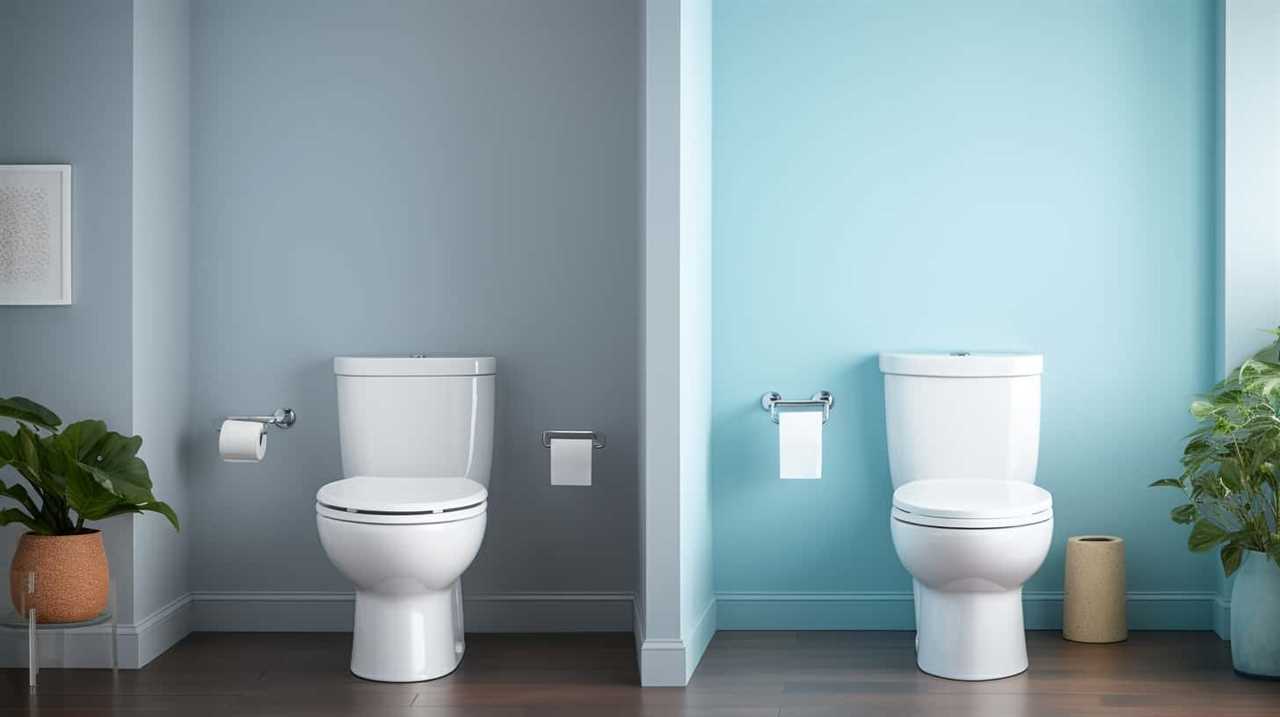
In addition to the environmental benefits, flushable cat litter also offers convenience and ease. Instead of scooping and bagging up the litter box waste, we can simply flush it down the toilet. This saves time and effort, making the process of maintaining a clean litter box much more convenient.
Considering both the environmental impact and the convenience and ease it provides, using flushable cat litter is a smart choice for cat owners. However, it’s important to consider certain factors when choosing the cheapest flushable cat litter.
Factors to Consider When Choosing the Cheapest Flushable Cat Litter
When selecting the cheapest flushable cat litter, there are several factors that we should take into consideration. Here are four key factors to keep in mind:
- Cost-effective options: Look for cat litters that offer the best value for money. Consider the price per pound or per use, as well as any discounts or bulk options available.
- Environmental impact: Opt for cat litters that are biodegradable and made from sustainable materials. This not only reduces waste but also minimizes the impact on the environment.
- Clumping ability: Choose a cat litter that forms strong clumps for easy scooping and cleaning. This ensures efficient use and reduces the frequency of litter box changes.
- Odor control: Look for cat litters that have effective odor control properties. This helps to keep your home smelling fresh and clean, even with a litter box in use.
Considering these factors will help you find the cheapest flushable cat litter that meets your budget, while also being environmentally friendly.
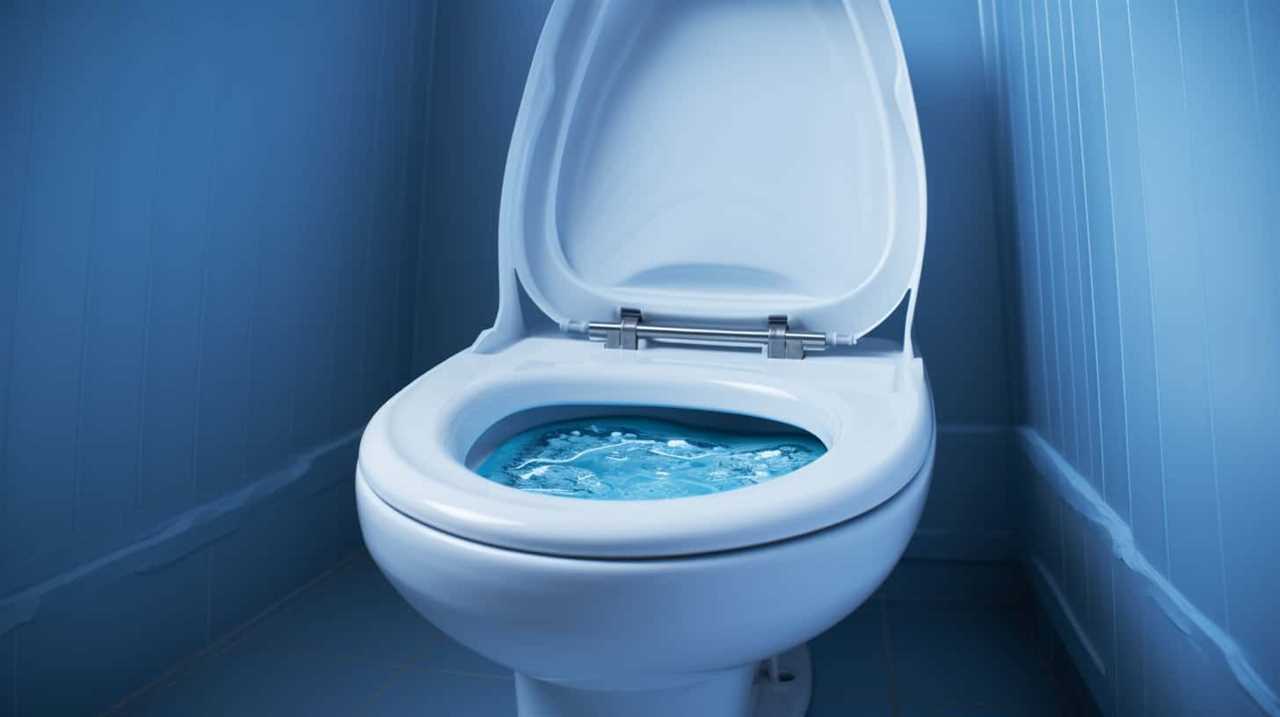
Now, let’s move on to a step-by-step guide on how to transition your cat to flushable litter.
Step-By-Step Guide on How to Transition Your Cat to Flushable Litter
To transition our cat to flushable litter, we found using a gradual approach to be the most effective. The transition process can be stressful for cats, so it’s important to take it slow and be patient.
Start by mixing a small amount of flushable litter with your cat’s current litter, gradually increasing the ratio over time. This allows your cat to become familiar with the new litter while still having the comfort of their old litter.
Additionally, provide alternative options for your cat, such as a separate litter box with their old litter, to ease the transition. Observe your cat’s behavior and adjust the transition pace accordingly.
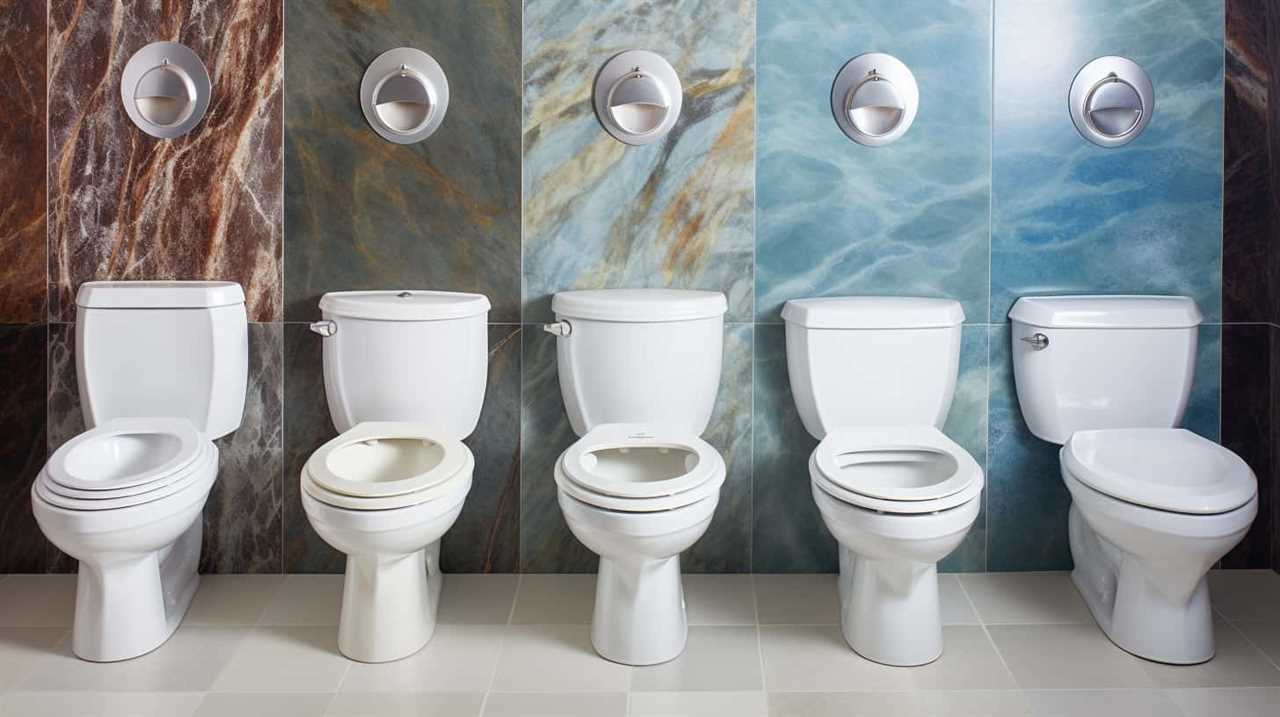
Remember to praise and reward your cat for using the flushable litter to reinforce positive associations. With time and patience, your cat will successfully transition to flushable litter.
Tips for Maintaining a Clean and Odor-Free Litter Box With Flushable Cat Litter
To maintain a clean and odor-free litter box with flushable cat litter, we recommend implementing a regular scooping routine. Here are some tips for reducing litter tracking and properly disposing of flushable cat litter:
- Place a litter mat or tray outside the litter box to catch any litter that may stick to your cat’s paws. This will help prevent it from being tracked around your home.
- Use a litter box with high sides or a covered litter box to contain any litter that may be kicked out during your cat’s digging and burying.
- Scoop the litter box at least once a day to remove any waste and clumps. This will help prevent odor buildup and keep the litter box clean for your cat.
- When disposing of flushable cat litter, make sure to follow the manufacturer’s instructions. Some brands can be safely flushed down the toilet, while others may require bagging and disposing of in the trash.
By following these tips, you can maintain a clean and odor-free litter box with flushable cat litter.
Now, let’s move on to the next section where we’ll provide reviews and recommendations for the top affordable flushable cat litters.
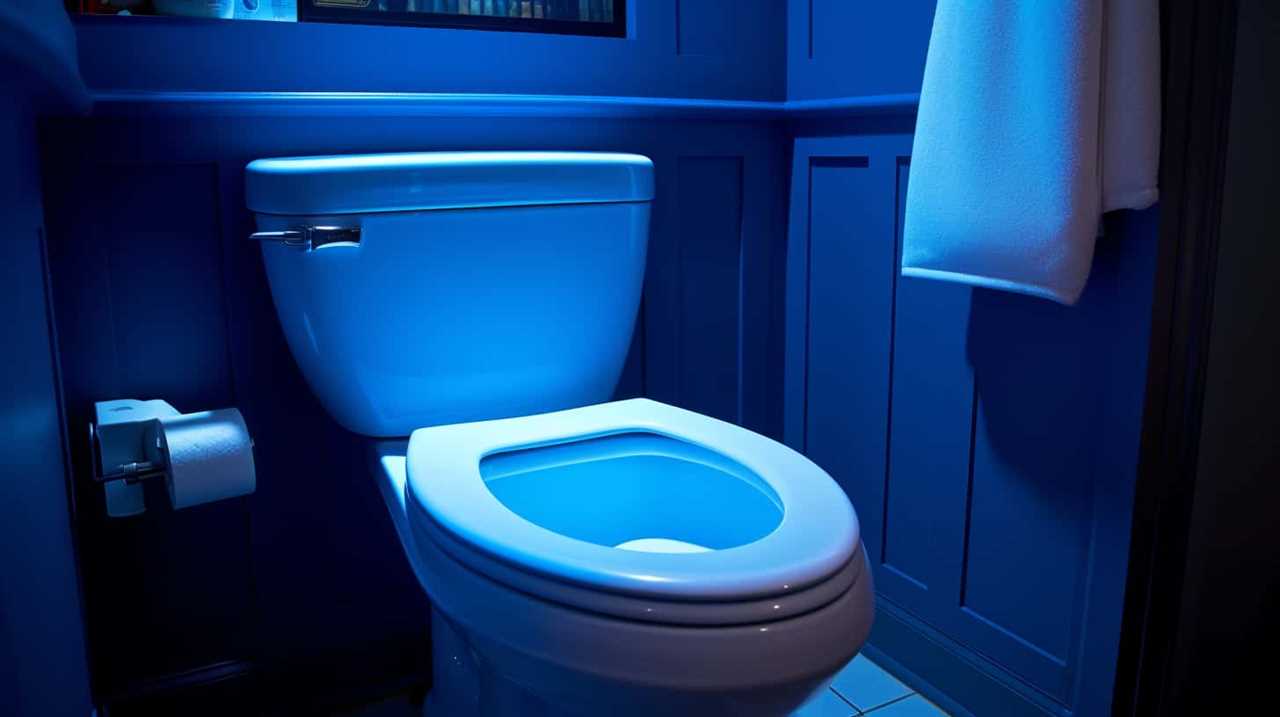
Reviews and Recommendations for the Top Affordable Flushable Cat Litters
Now, let’s dive into our reviews and recommendations for the top affordable flushable cat litters.
When considering flushable cat litters, it’s important to evaluate their environmental impact. The advantage of flushable cat litter lies in its ability to be safely disposed of through the toilet, reducing waste in landfills. However, it’s crucial to choose a litter made from biodegradable materials to ensure minimal impact on the environment.
Additionally, when comparing the cost effectiveness of flushable cat litter with traditional options, it’s essential to consider factors such as lifespan and frequency of litter changes. While flushable cat litter may initially seem more expensive, it can be cost-effective in the long run due to its longer lifespan and reduced waste management costs.
Frequently Asked Questions
Can Flushable Cat Litter Be Used in All Types of Litter Boxes?
Yes, flushable cat litter can be used in all types of litter boxes. However, it is important to consider the pros and cons of using flushable cat litter alternatives before making a decision.
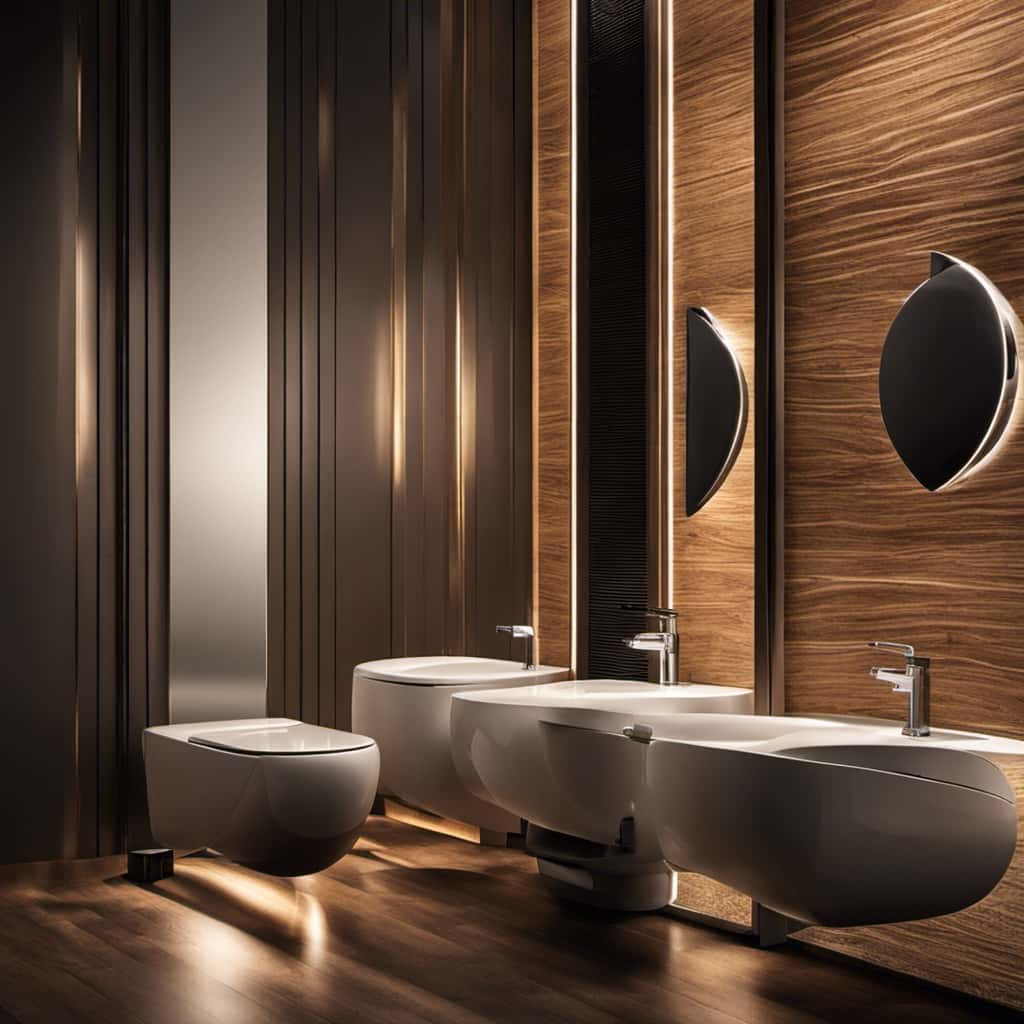
Is Flushable Cat Litter Safe for Septic Systems?
Flushable cat litter may be convenient, but is it safe for septic systems? While it is touted as eco-friendly, the pros and cons should be considered. Is flushable cat litter safe for the environment?
How Often Should I Flush the Litter When Using Flushable Cat Litter?
When using flushable cat litter, we flush it every time our cat uses the litter box. This ensures cleanliness and prevents odors. However, there are alternatives to flushable cat litter that may be more cost-effective.
Can I Mix Flushable Cat Litter With Regular Cat Litter?
When considering mixing cat litter, it’s important to note that flushable and regular litter have different compositions and functionalities. It’s best to avoid mixing them to maintain the effectiveness of flushable litter and explore alternatives to flushable litter instead.
Are There Any Specific Brands of Flushable Cat Litter That Are More Environmentally Friendly?
There are alternative eco-friendly options available when it comes to flushable cat litter. Using flushable litter has several benefits, such as reducing waste and being more environmentally friendly compared to traditional cat litter.
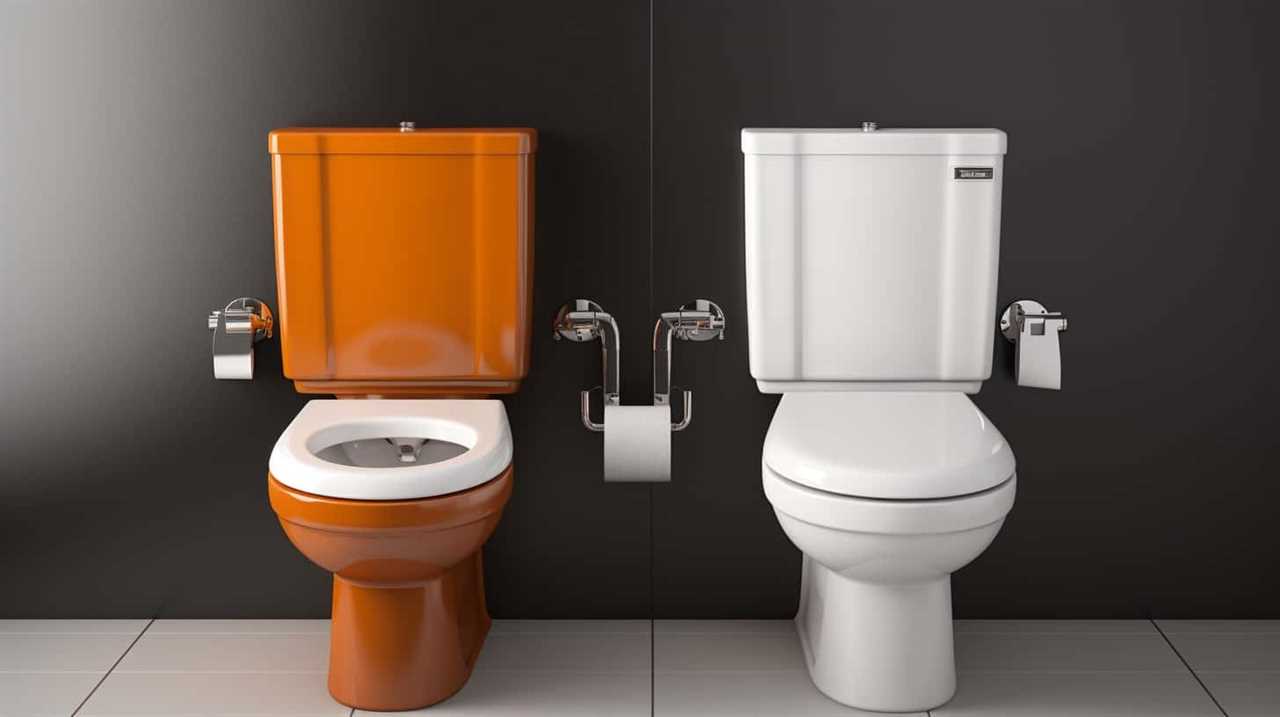
Conclusion
In conclusion, finding the cheapest flushable cat litter can be a game-changer for both you and your feline friend. By considering factors such as cost, effectiveness, and environmental impact, you can make an informed decision.
Transitioning your cat to flushable litter may require patience, but it’s worth it in the long run. With proper maintenance, you can keep your litter box clean and odor-free.
So why not give it a try and experience the convenience and efficiency of flushable cat litter? It’s like finding a hidden treasure for both you and your cat!
With an impeccable eye for detail and a passion for bathroom-related, Ava leads our editorial team gracefully and precisely.
Under her guidance, Best Modern Toilet has flourished as the go-to resource for modern bathroom enthusiasts. In her free time, you might find Ava exploring antique shops and looking for vintage bathroom fixtures to add to her collection.
FAQ - Advanced Bathroom Queries
Can You Force Flush a Toilet
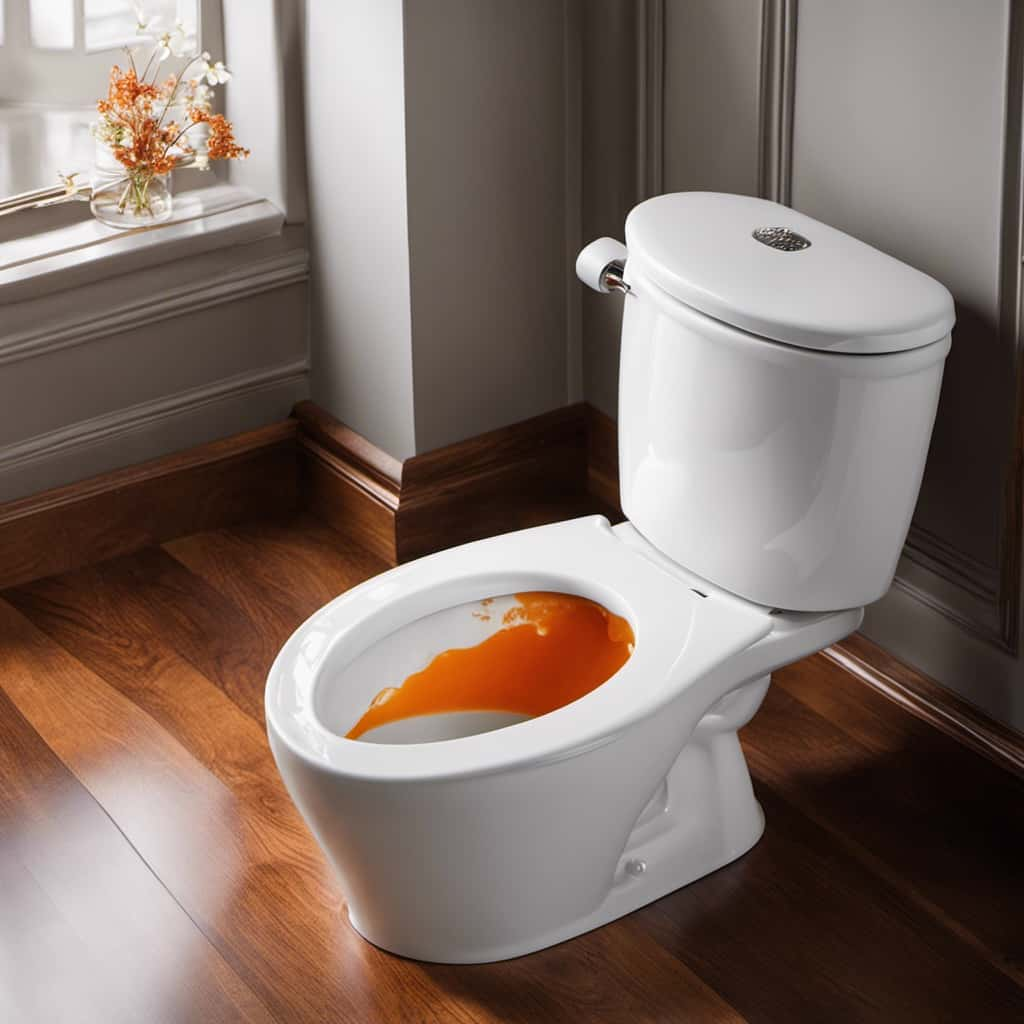
Yes, you can unleash the power of a force flush on your toilet! Have you ever thought about it before? We’re here to let you know that it is possible!
In this article, we will delve into the mechanics of a toilet flush and explain when a force flush is necessary.
We’ll also provide you with a step-by-step guide and tips for a successful force flush.
So, buckle up and get ready to master the art of force flushing your toilet!
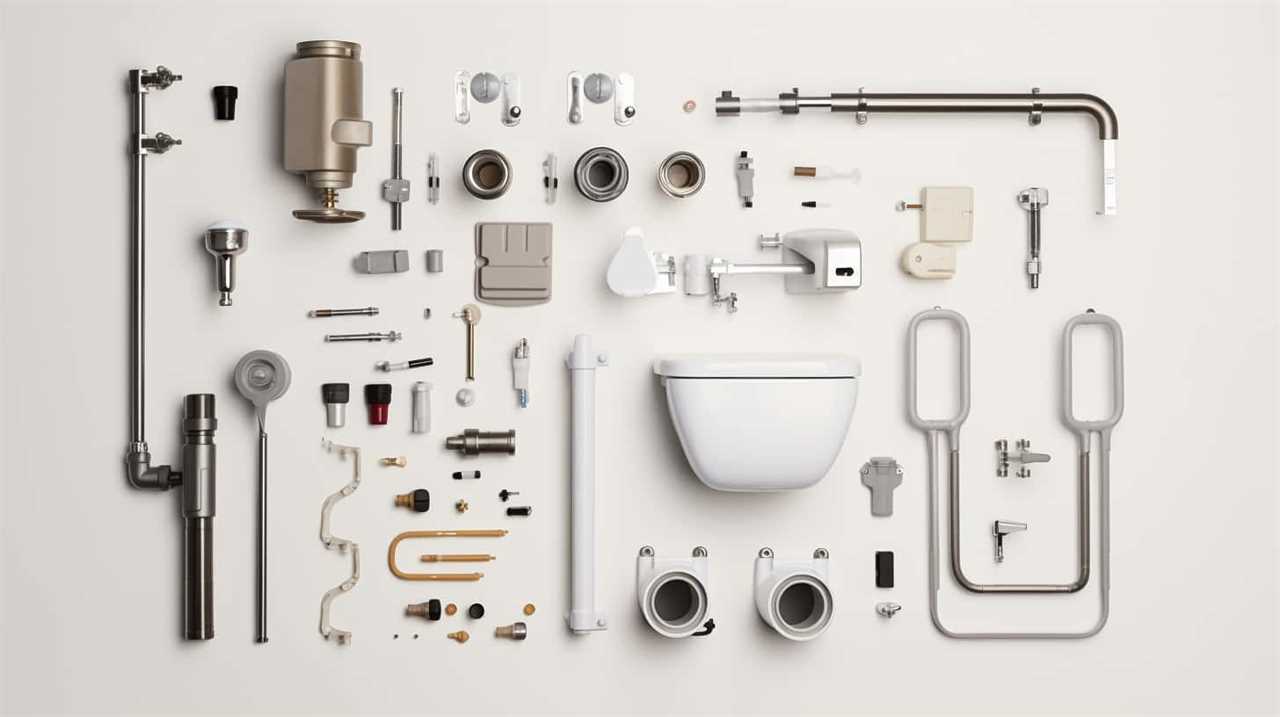
Key Takeaways
- The flush lever lifts the flapper, allowing water to rush into the bowl.
- Troubleshooting weak flushes, inconsistent water levels, or clogs involves checking the water supply, flush valve, and tank components.
- If conventional methods fail to unclog a toilet, calling a professional plumber may be necessary.
- Tools and equipment for force flushing a toilet include a plunger, high-pressure water source, rubber gloves, towels, and a bucket or pail.
Understanding the Mechanics of a Toilet Flush
To understand the mechanics of a toilet flush, we’ll delve into the workings of its water flow and pressure.
The toilet flush mechanism is a complex system that relies on the proper functioning of several components. When the flush lever is pressed, it lifts the flapper, allowing water from the tank to rush into the bowl. This creates a strong force that pushes waste down the drain.
However, if you’re experiencing issues with your toilet flush, troubleshooting the problem can be a bit challenging. Common issues include weak flushes, inconsistent water levels, or clogs.
It’s important to check the water supply, the flush valve, and the tank components for any signs of damage or malfunction. By understanding the inner workings of the toilet flush mechanism, you can effectively troubleshoot and fix any issues that arise.
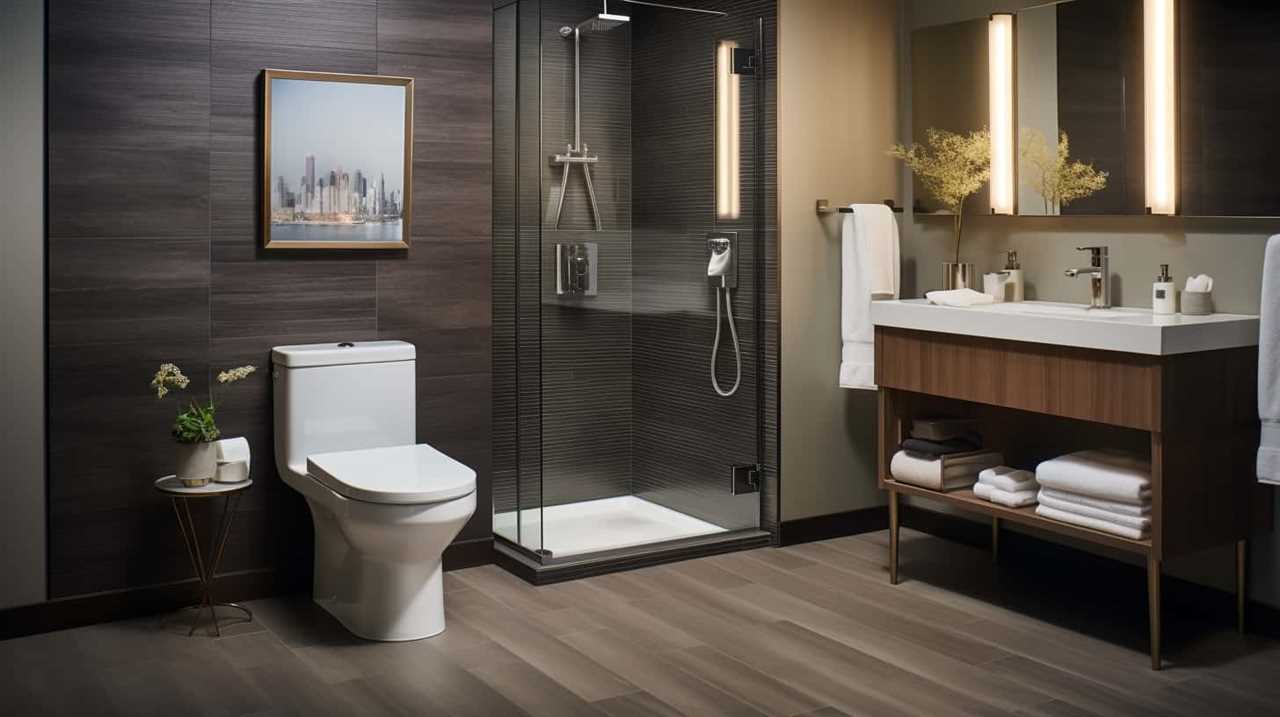
Identifying When a Force Flush Is Necessary
When identifying the instances in which a force flush is necessary, we must consider the factors that may contribute to a weak or ineffective flush. Signs of a clogged toilet include water that rises to the rim or drains slowly, gurgling sounds, or a foul odor. If these signs persist despite attempts to unclog the toilet using a plunger or other methods, it may be time to call a professional plumber.
A professional plumber has the expertise and tools to effectively diagnose and resolve complex clogs that can’t be cleared through conventional means. Knowing when to call a professional plumber can prevent further damage to your plumbing system and ensure a proper force flush is performed if necessary.
With an understanding of when a force flush is needed, let’s now explore the tools and equipment required for this process.
Tools and Equipment for Force Flushing a Toilet
We will need specific tools and equipment to successfully force flush a toilet. Here are the essential items you’ll need:
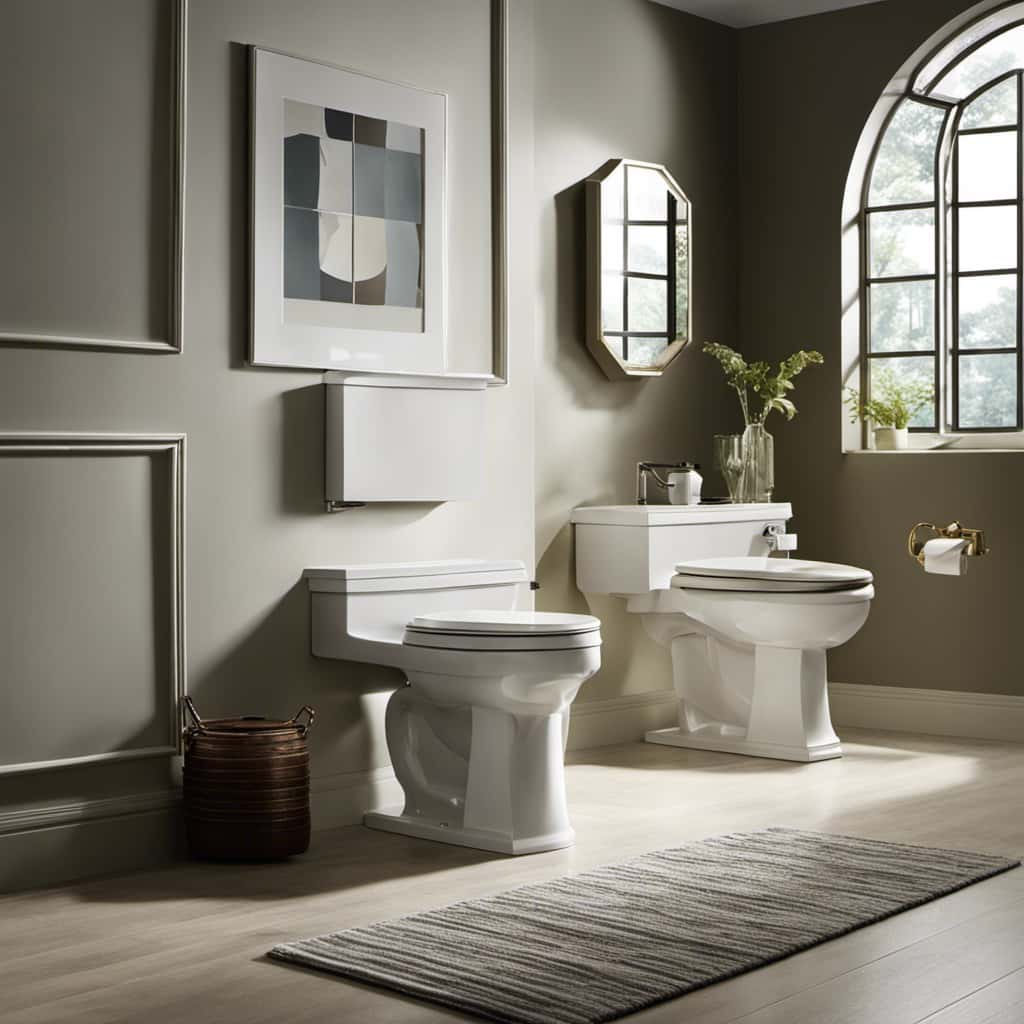
- Plunger: A plunger is a basic tool used to create pressure and force water through the drain. Choose a plunger with a flange or extension at the bottom for better seal and suction.
- High-pressure water source: To generate a forceful flush, you’ll need a high-pressure water source. This can be a handheld bidet sprayer, a pressure washer, or even a garden hose with a nozzle attachment.
- Rubber gloves: Protect your hands from any potential mess or bacteria by wearing rubber gloves. This will also provide a better grip on the plunger.
- Towels: Keep towels handy to clean up any spills or splashes that may occur during the force flushing process.
- Bucket or pail: Have a bucket or pail nearby to collect any excess water that may overflow during the force flushing.
Step-by-Step Guide to Force Flushing a Toilet
To successfully force flush a toilet, we will need to follow a step-by-step guide. Below is a table that outlines the process, along with some alternative methods for unclogging toilets.
| Step | Action |
|---|---|
| 1 | Put on protective gloves and eyewear. |
| 2 | Check for common toilet problems like a clogged trap or blocked vent pipe. |
| 3 | If the toilet is not clogged, try a plunger to force water down the drain. |
| 4 | If the plunger doesn’t work, try using a toilet auger to remove the blockage. |
| 5 | If all else fails, use a force flush by pouring a bucket of water into the toilet bowl. |
By following these steps, you can effectively force flush a toilet and resolve common toilet problems. In the next section, we will discuss some tips and precautions for a successful force flush.
Now, let’s move on to the tips and precautions for a successful force flush.
Tips and Precautions for a Successful Force Flush
Now, let’s explore some essential tips and precautions to ensure a successful force flush of the toilet.
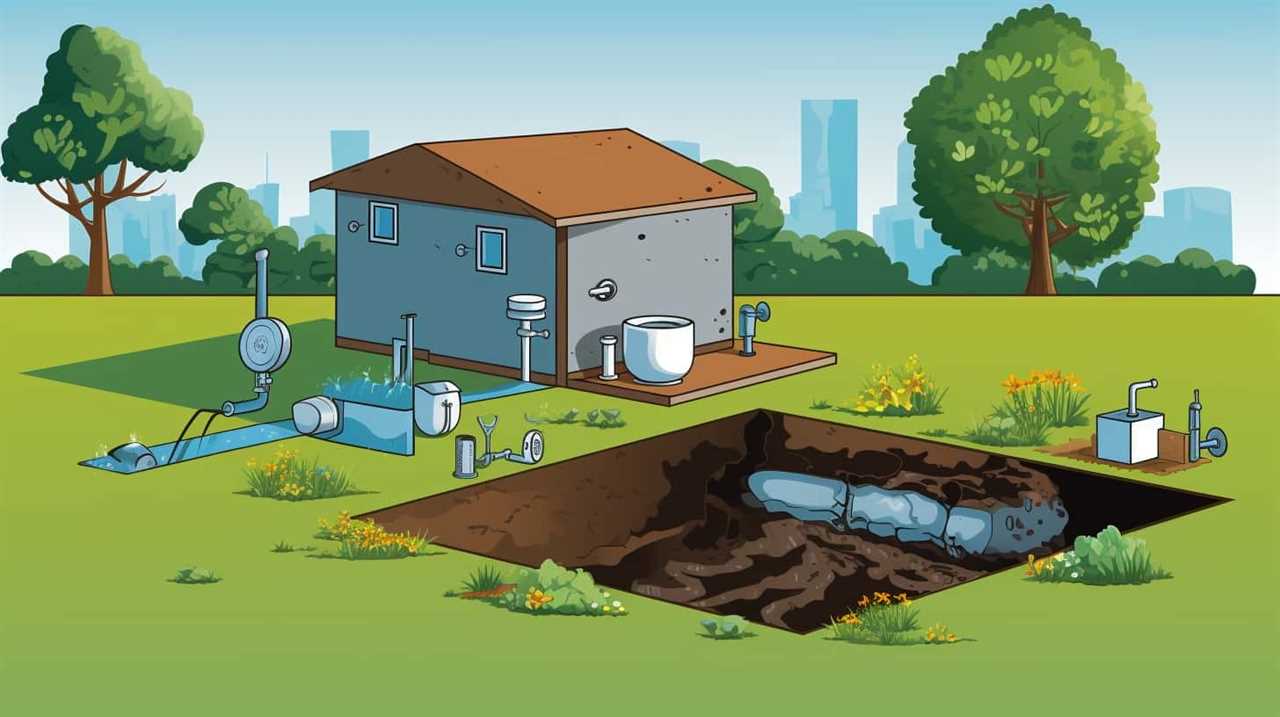
Here are some tips to prevent clogs and troubleshoot common issues:
- Use a plunger: A plunger is an effective tool for force flushing a toilet. Ensure a tight seal around the drain and use vigorous up-and-down motions to create suction and dislodge any blockage.
- Apply lubricant: If the plunger doesn’t work, try applying a small amount of lubricant, such as dish soap or petroleum jelly, around the rim of the plunger. This can improve suction and increase the chances of a successful force flush.
- Avoid excessive force: While force flushing is necessary in some cases, it’s important to avoid using excessive force as it can damage the toilet or pipes. Apply firm pressure, but be cautious.
- Check the water level: Before attempting a force flush, ensure that the water level in the toilet bowl isn’t too high. If it is, remove some water using a bucket or cup to prevent overflow.
- Call a professional: If force flushing doesn’t resolve the issue or if you encounter any other problems, it’s best to call a professional plumber. They have the expertise to handle complex toilet issues.
Frequently Asked Questions
How Long Does It Typically Take to Force Flush a Toilet?
Typically, it takes a few minutes to force flush a toilet. Common mistakes when trying to force flush include using excessive force, not checking the water level, or ignoring clogs. To troubleshoot a toilet that won’t force flush, check the water level, inspect for clogs, and ensure the flapper is functioning properly.
Can Force Flushing a Toilet Cause Any Damage to the Plumbing System?
Force flushing a toilet without proper knowledge or tools can potentially cause significant damage to the plumbing system. To prevent this, it’s crucial to understand the risks involved and take necessary precautions to ensure the integrity of the plumbing is maintained.
Is It Possible to Force Flush a Toilet Without Using Any Tools or Equipment?
Yes, you can force flush a toilet without using any tools or equipment. Some natural methods for unclogging toilets include using hot water, vinegar and baking soda, or a plunger. These DIY solutions can help resolve toilet flushing issues.
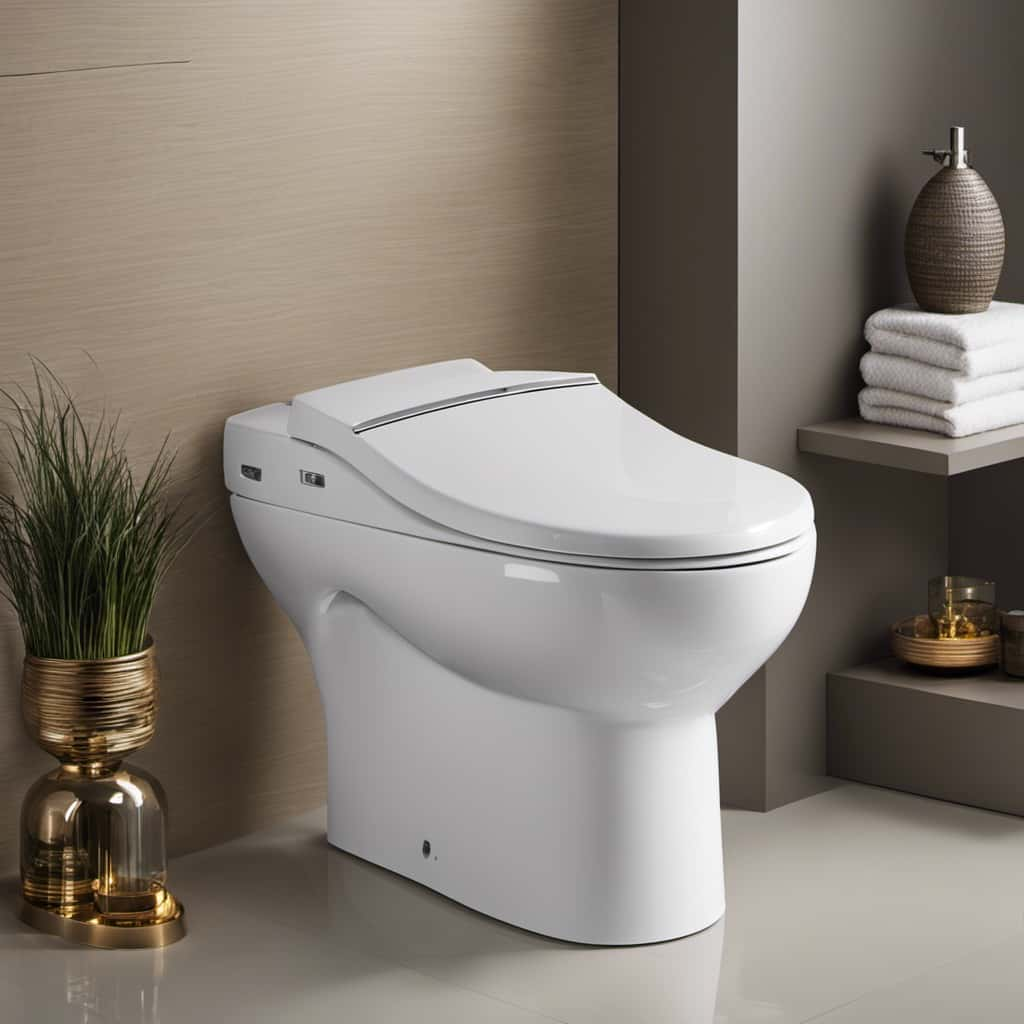
What Are Some Common Signs That Indicate a Force Flush Might Be Necessary?
Common signs that indicate a force flush might be necessary include water backing up, slow draining, and repeated clogs. To prevent clogs and avoid force flushing, proper maintenance and avoiding flushing non-flushable items are essential.
Are There Any Alternative Methods to Force Flushing a Toilet if the Recommended Tools Are Not Available?
Yes, there are alternative methods to force flush a toilet if the recommended tools are not available. DIY techniques such as pouring hot water or using a plunger can help resolve the issue.
Conclusion
In conclusion, understanding the mechanics of a toilet flush is essential for identifying when a force flush is necessary. By following a step-by-step guide and using the right tools and equipment, you can successfully force flush a toilet.
Remember to exercise caution and follow the tips provided for a smooth and efficient flush. With these techniques, you’ll be able to unclog even the most stubborn toilets with the force of a thousand storms!
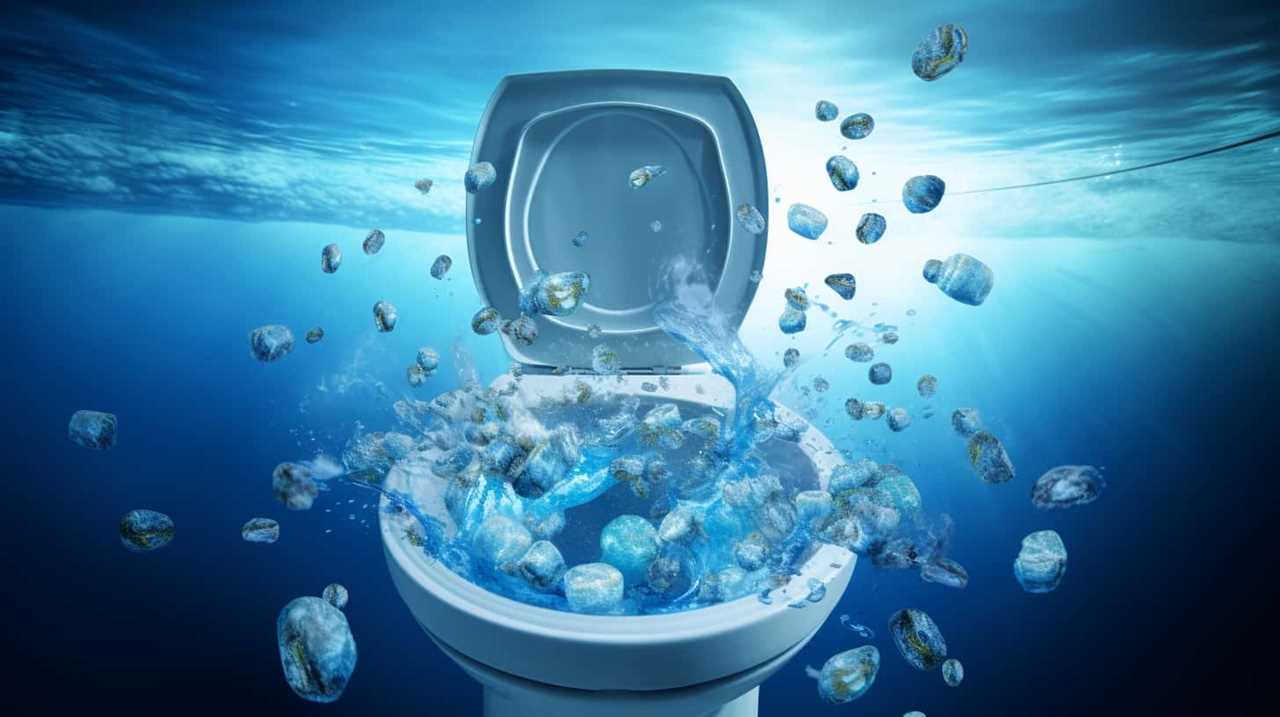
With an impeccable eye for detail and a passion for bathroom-related, Ava leads our editorial team gracefully and precisely.
Under her guidance, Best Modern Toilet has flourished as the go-to resource for modern bathroom enthusiasts. In her free time, you might find Ava exploring antique shops and looking for vintage bathroom fixtures to add to her collection.
FAQ - Advanced Bathroom Queries
Why Can’t You Flush Toilet Roll in Greece

Curious as to why toilet paper cannot be flushed in Greece? Allow us to provide some insight.
The plumbing infrastructure in Greece, although modern, is not designed to handle the disposal of toilet paper. Flushing it can lead to clogs and damage to the sewage system.
But don’t worry, we’ve got you covered. In this article, we’ll explore the reasons behind this practice, its environmental impact, and the alternatives commonly used in Greece.
Get ready to dive into the fascinating world of Greek toilet paper etiquette!
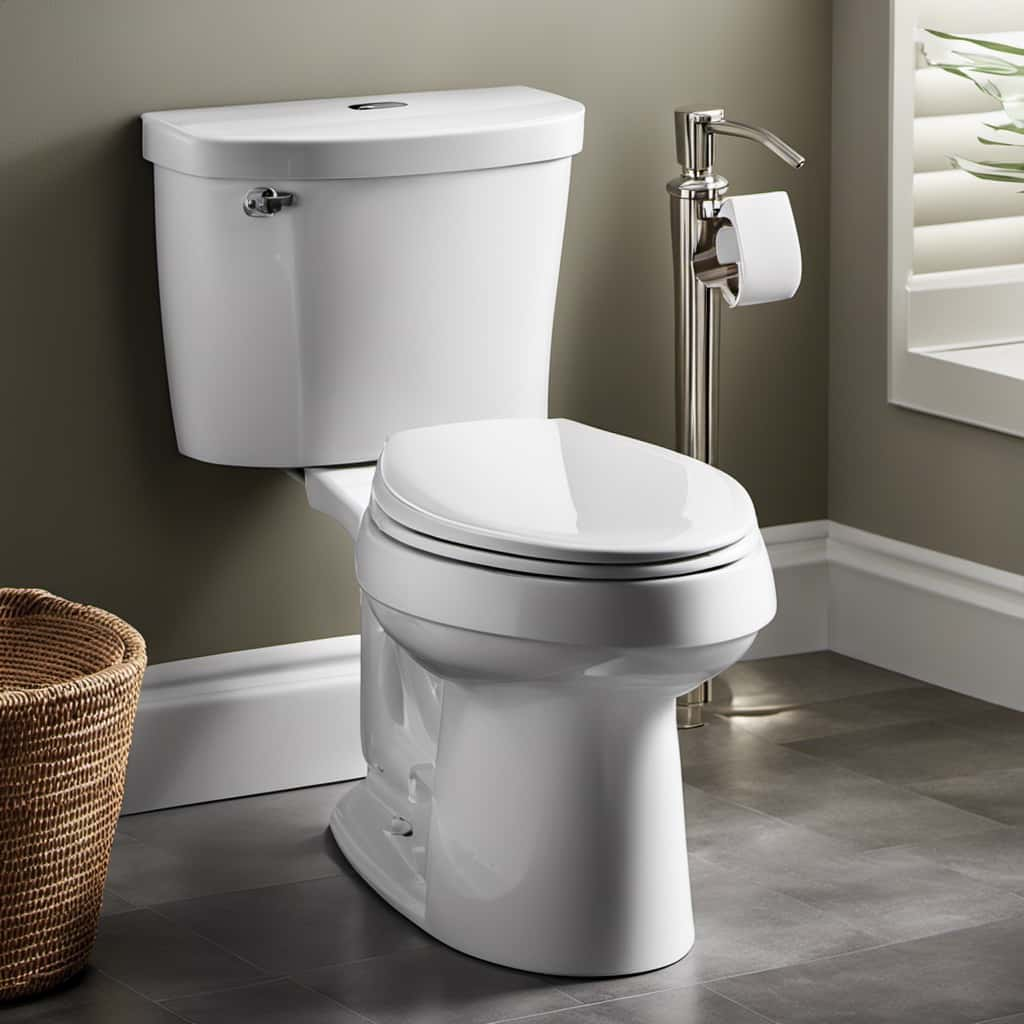
Key Takeaways
- Modern plumbing infrastructure in Greece is not designed to handle the disposal of toilet paper.
- Flushing toilet paper can lead to clogs and damage to the sewage system.
- Greece relies heavily on septic tanks, which have limited capacity to handle non-biodegradable materials like toilet paper.
- Aging infrastructure, limited capacity, and lack of maintenance contribute to the challenges in maintaining sewage systems in Greece.
Plumbing Infrastructure in Greece
Why is the plumbing infrastructure in Greece unable to handle flushing toilet paper?
Well, it all comes down to septic tank limitations and plumbing regulations.
Greece has a unique sewage system design that relies heavily on septic tanks. These tanks are designed to handle organic waste, such as human waste and toilet paper. However, they’ve limited capacity and aren’t equipped to handle large amounts of non-biodegradable materials like toilet paper.
To prevent clogging and potential damage to the system, it’s necessary to dispose of toilet paper in a separate bin provided in most restrooms. This may seem inconvenient, especially for those accustomed to simply flushing it down the toilet. However, it’s a necessary precaution to ensure the proper functioning of Greece’s plumbing infrastructure and sewage system design.
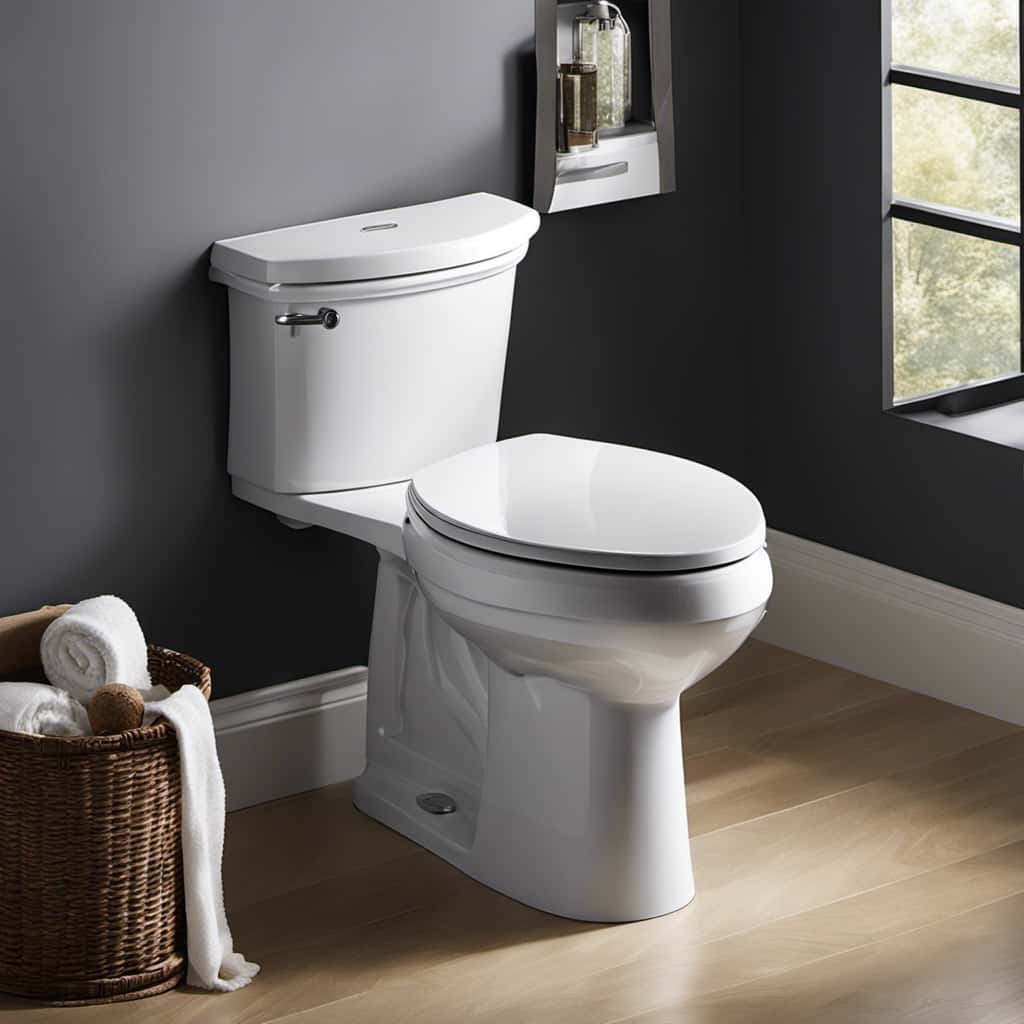
Now, let’s delve into the specifics of this unique sewage system design in Greece.
Sewage System Design in Greece
To understand the sewage system design in Greece and its limitations on flushing toilet paper, let’s delve into the unique infrastructure that relies on septic tanks and their capacity to handle non-biodegradable materials.
In Greece, municipal waste management is a significant challenge, and this extends to the sewage systems. Here are some key factors that contribute to the challenges in maintaining sewage systems in Greece:
- Aging infrastructure: Many sewage systems in Greece were built decades ago and haven’t been adequately updated or expanded to keep up with the growing population and increased waste production.
- Limited capacity: The septic tanks used in Greece have limited capacity to handle non-biodegradable materials like toilet paper, leading to frequent blockages and malfunctions.
- Lack of proper maintenance: Due to budget constraints and other priorities, the maintenance of sewage systems is often neglected, exacerbating the problems.
Understanding these challenges is crucial in comprehending the environmental impact of flushing toilet paper in Greece and finding sustainable solutions.

Environmental Impact of Flushing Toilet Paper
As we delve into the environmental impact of flushing toilet paper in Greece, it’s important to consider the consequences of disposing non-biodegradable materials into the aging sewage systems. The improper disposal of toilet paper can have detrimental effects on the environment. Flushing toilet paper contributes to paper waste management issues, as it adds to the volume of waste that needs to be treated and processed. This can put a strain on the already burdened sewage systems in Greece.
Additionally, excessive water usage from flushing toilet paper can conflict with water conservation measures that are in place to address water scarcity issues in the country. Therefore, it’s crucial to explore alternative methods of disposing of toilet paper to mitigate these environmental concerns.
Now, let’s transition into discussing the common alternatives to flushing toilet paper in Greece.
Common Alternatives to Flushing Toilet Paper in Greece
Now that we’ve explored the environmental impact of flushing toilet paper in Greece, let’s delve into the common alternatives we can use to avoid flushing it.
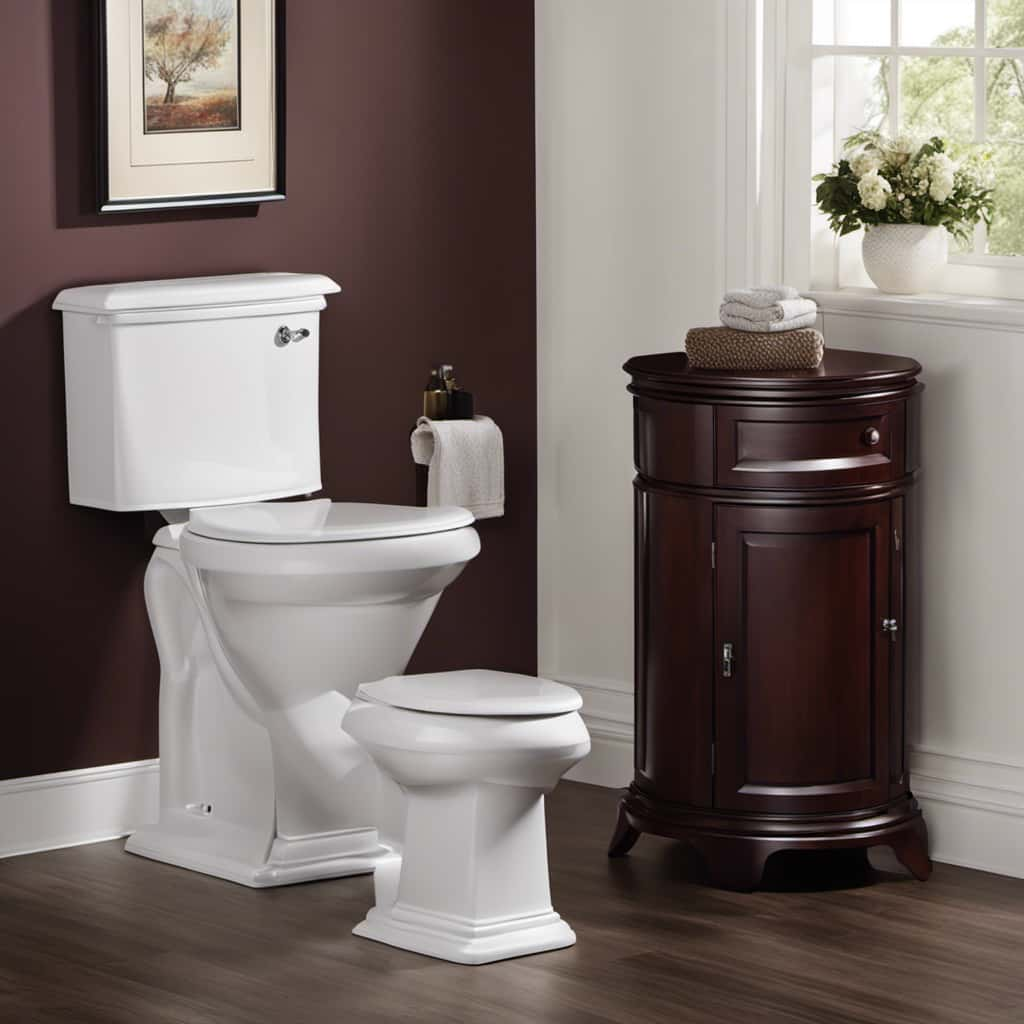
In Greece, bidet usage is a popular alternative to flushing toilet paper. Bidets are bathroom fixtures that spray water to clean oneself after using the toilet. They’re effective in removing waste without the need for toilet paper.
Another alternative is the use of composting toilets. These toilets are designed to convert human waste into compost that can be safely used as fertilizer. They use natural processes to break down waste, eliminating the need for flushing or traditional sewage systems.
Both bidet usage and composting toilets offer sustainable and hygienic alternatives to flushing toilet paper in Greece.
Cultural Norms and Etiquette Around Toilet Paper in Greece
In Greece, our cultural norms and etiquette dictate proper disposal methods for toilet paper. Unlike in many other countries, it isn’t common practice to flush toilet paper down the toilet. Instead, we’ve specific customs for disposing of it. This may seem strange to outsiders, but there are historical reasons behind this tradition.
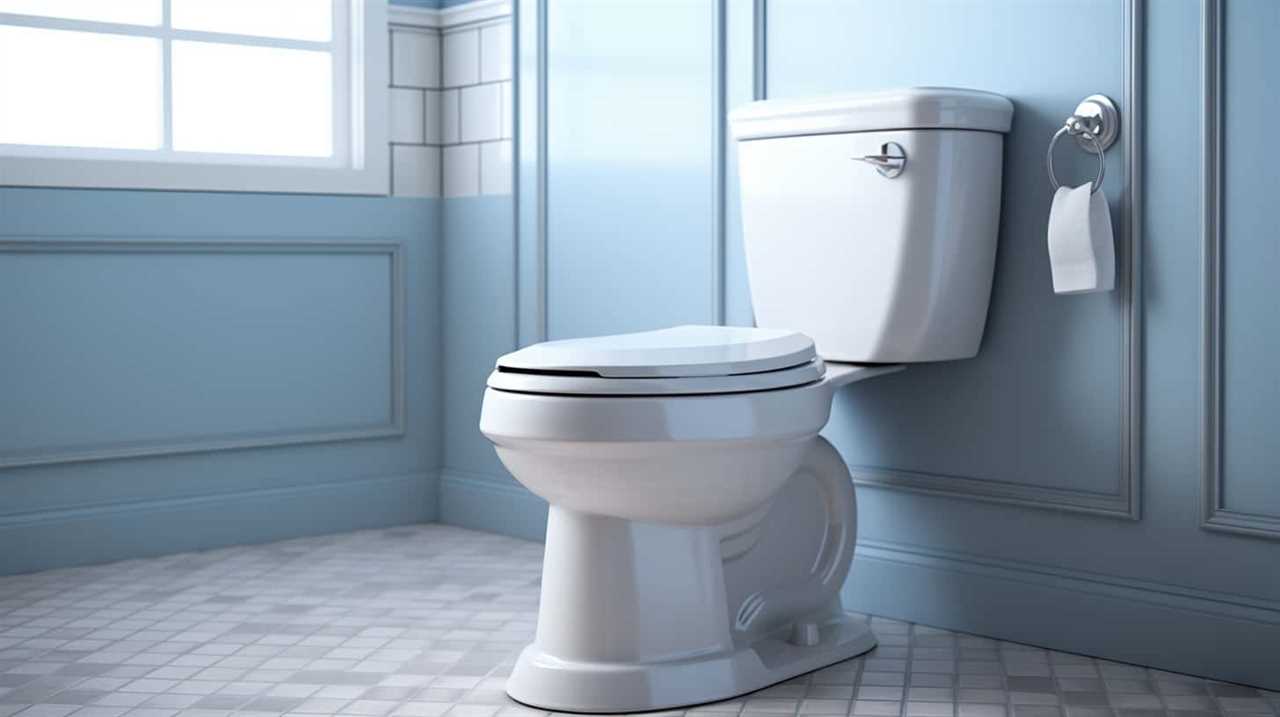
One of the main reasons for not flushing toilet paper in Greece is the age and condition of our plumbing systems. Many older buildings and houses have outdated pipes that aren’t designed to handle the flushing of toilet paper. Flushing it can lead to blockages and costly repairs.
Another reason is the concern for environmental impact. By not flushing toilet paper, we reduce the amount of waste that goes into the sewage system. This helps to protect our natural resources and minimize pollution.
Conclusion
In conclusion, when it comes to flushing toilet paper in Greece, it’s important to be mindful of the plumbing infrastructure and environmental impact. While it may not be the norm to flush toilet paper in Greece, there are alternative options available.
Understanding the cultural norms and etiquette around toilet paper can help us navigate this aspect of daily life in Greece with ease and respect. So, let’s embrace the unique customs and practices that make Greece truly special.
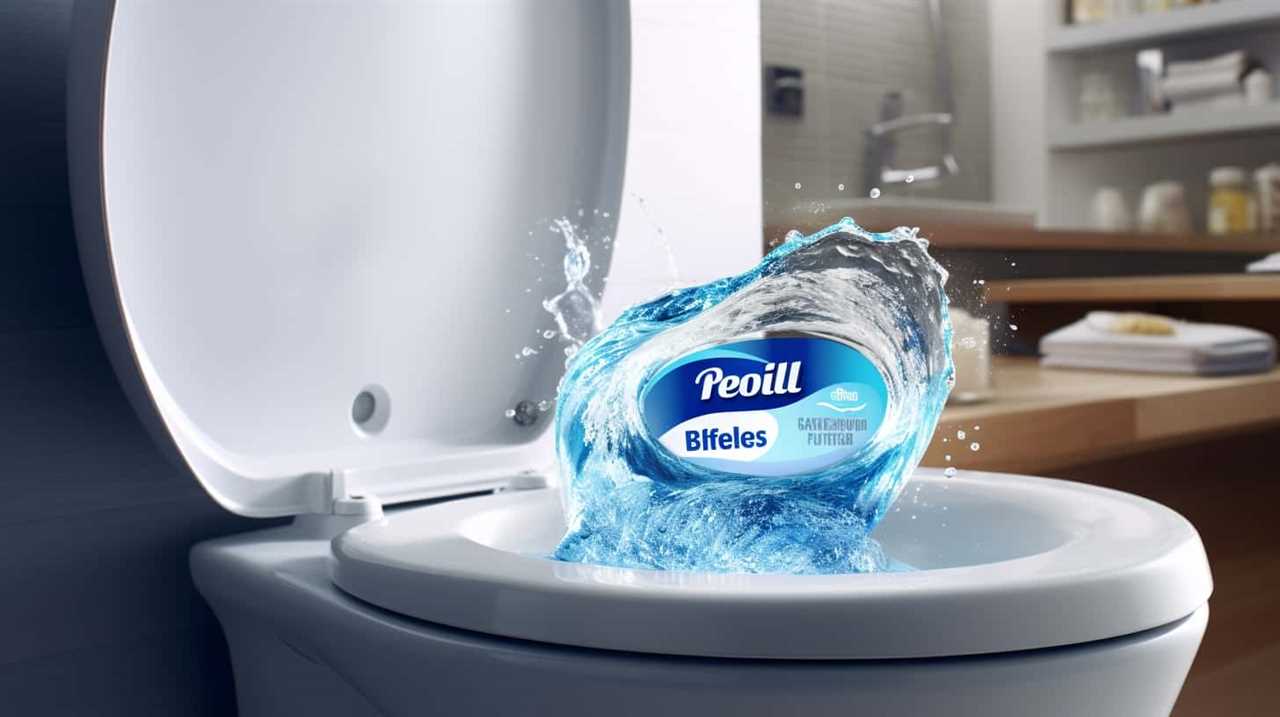
With an impeccable eye for detail and a passion for bathroom-related, Ava leads our editorial team gracefully and precisely.
Under her guidance, Best Modern Toilet has flourished as the go-to resource for modern bathroom enthusiasts. In her free time, you might find Ava exploring antique shops and looking for vintage bathroom fixtures to add to her collection.
-
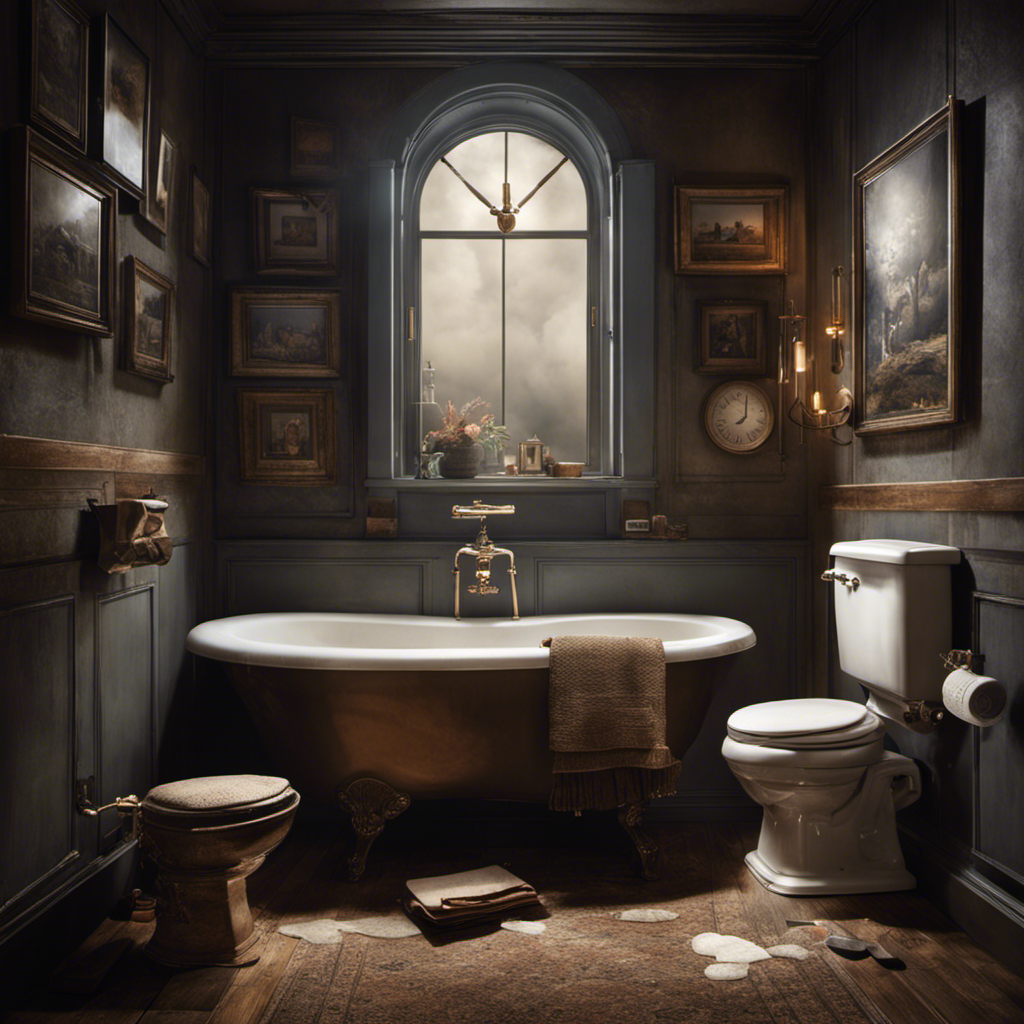
 FAQ - Advanced Bathroom Queries3 months ago
FAQ - Advanced Bathroom Queries3 months agoWhat Happens if You Sit on the Toilet Too Long
-
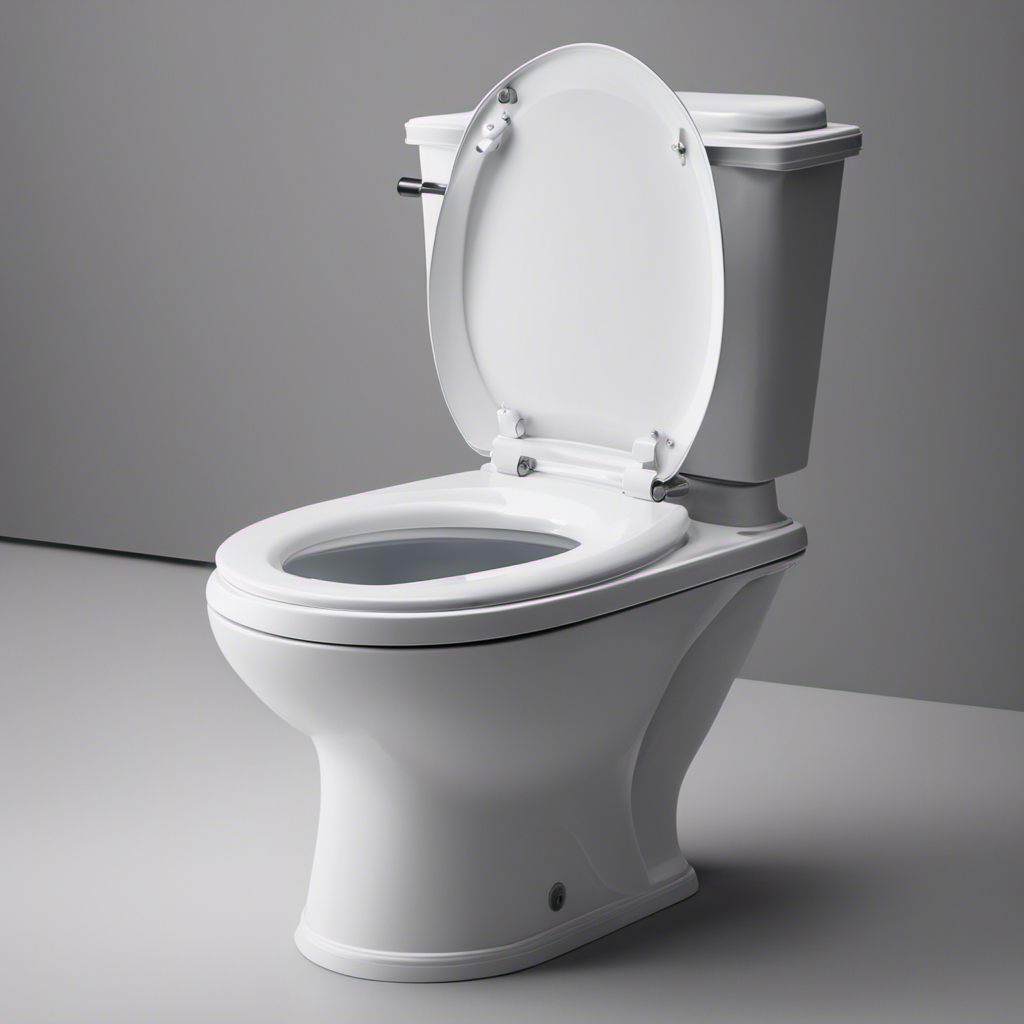
 FAQ - Advanced Bathroom Queries3 months ago
FAQ - Advanced Bathroom Queries3 months agoWhy Is My Toilet so Loud When Refilling
-
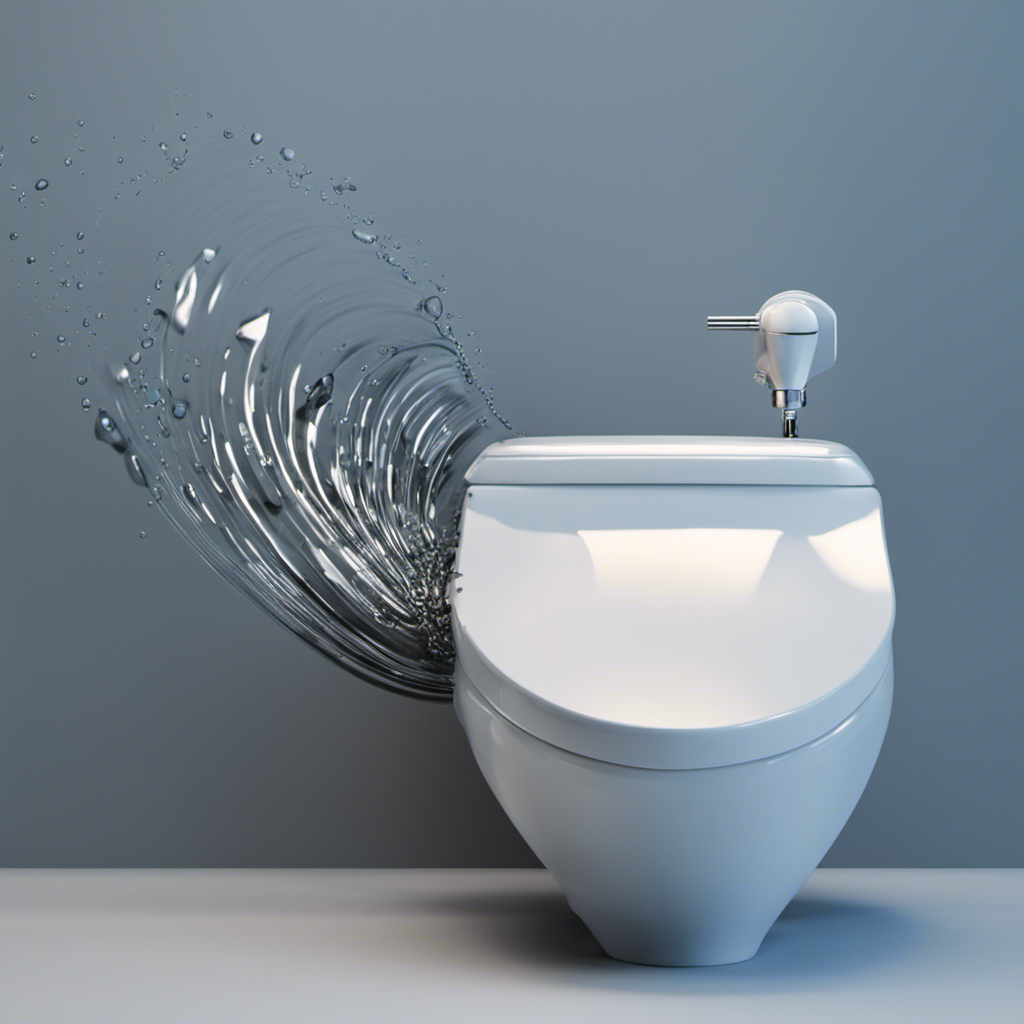
 Guides3 months ago
Guides3 months agoTroubleshooting Dropping Water Level in Toilet Bowl: Causes and Solutions
-
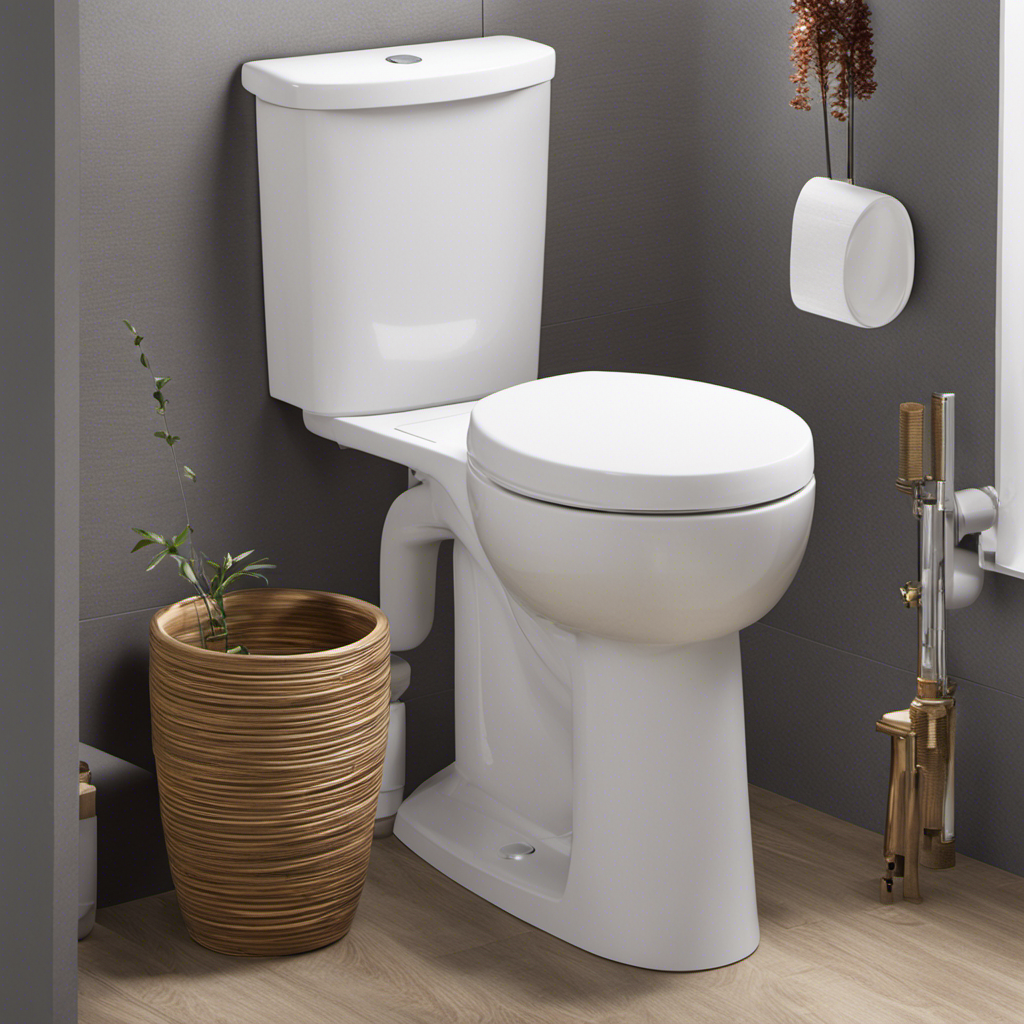
 Guides3 months ago
Guides3 months agoToilet Water Supply Line Sizes: Finding the Right Fit
-

 FAQ - Advanced Bathroom Queries3 months ago
FAQ - Advanced Bathroom Queries3 months agoWhat Happens When You Put Baking Soda in Your Toilet
-
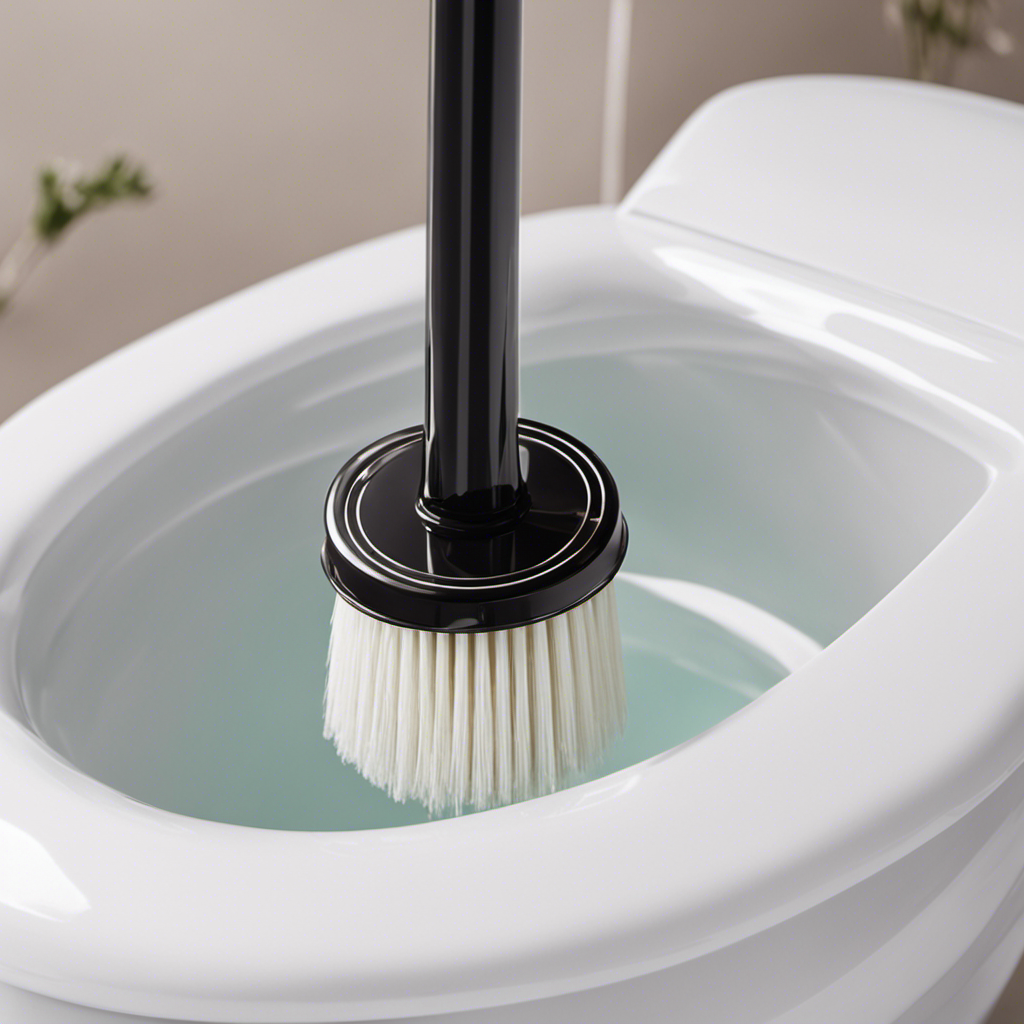
 Guides3 months ago
Guides3 months agoHow to Remove Crystallized Urine From Toilet Bowl
-
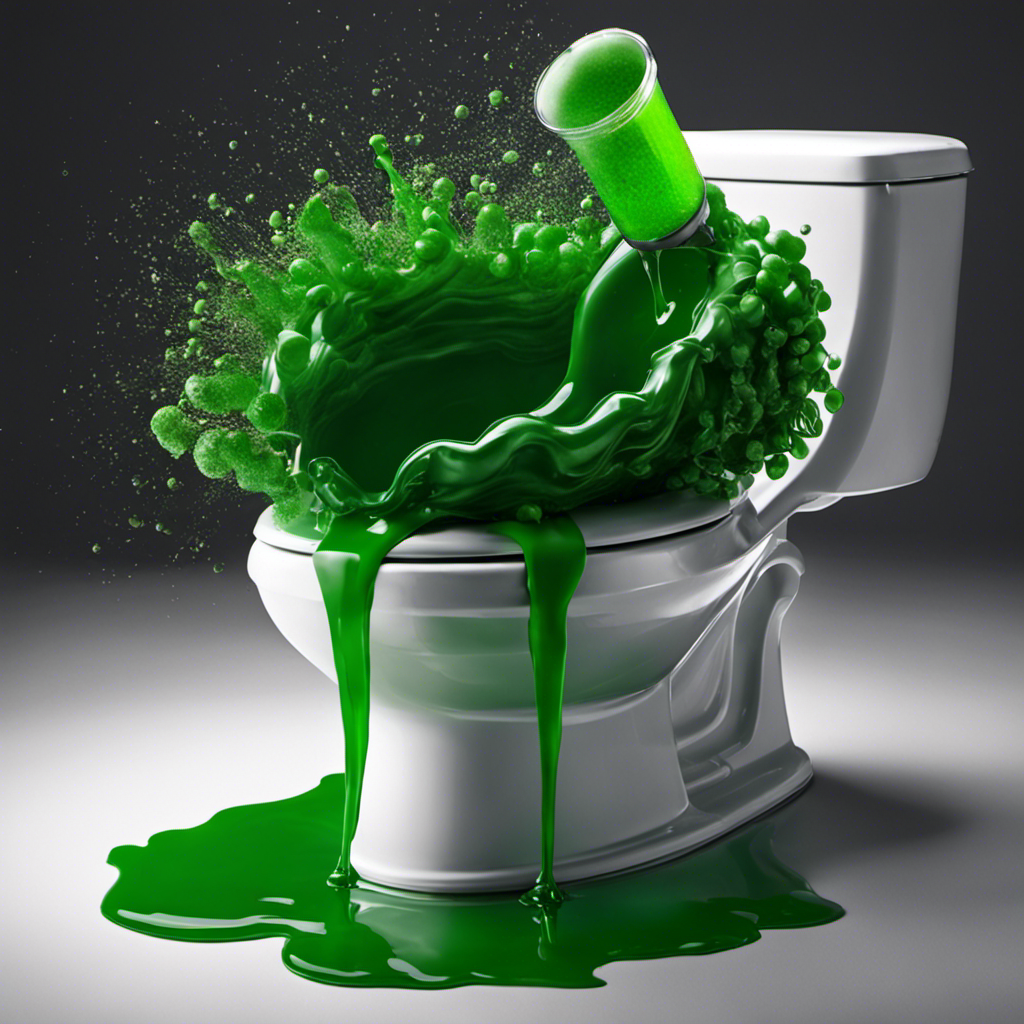
 Guides3 months ago
Guides3 months agoHow to Use Green Gobbler in Toilet
-
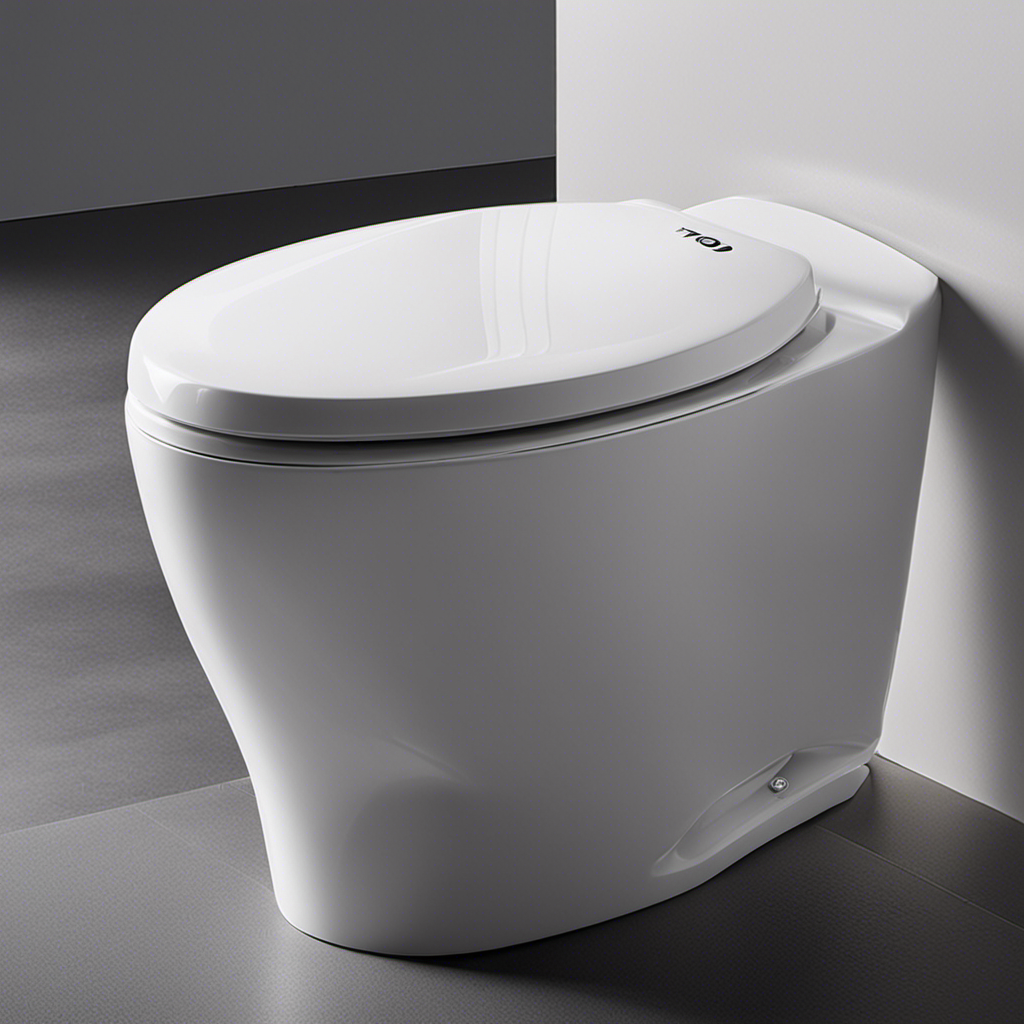
 Toilet Brands3 months ago
Toilet Brands3 months agoFinding the Model Number of Toto Toilets: A Guide





















